Falcons are a large and diverse family of raptors, with over 60 species occurring worldwide. They are adapted for a variety of habitats and diets, with some species specializing in hunting small mammals, insects, and even other birds.
Falcons are renowned for their impressive aerial acrobatics, which they use to capture prey in mid-air. With their long, pointed wings and swift, powerful flight, they are incredibly efficient hunters, and are considered one of the most efficient predatory birds in the world.
1. Peregrine Falcon
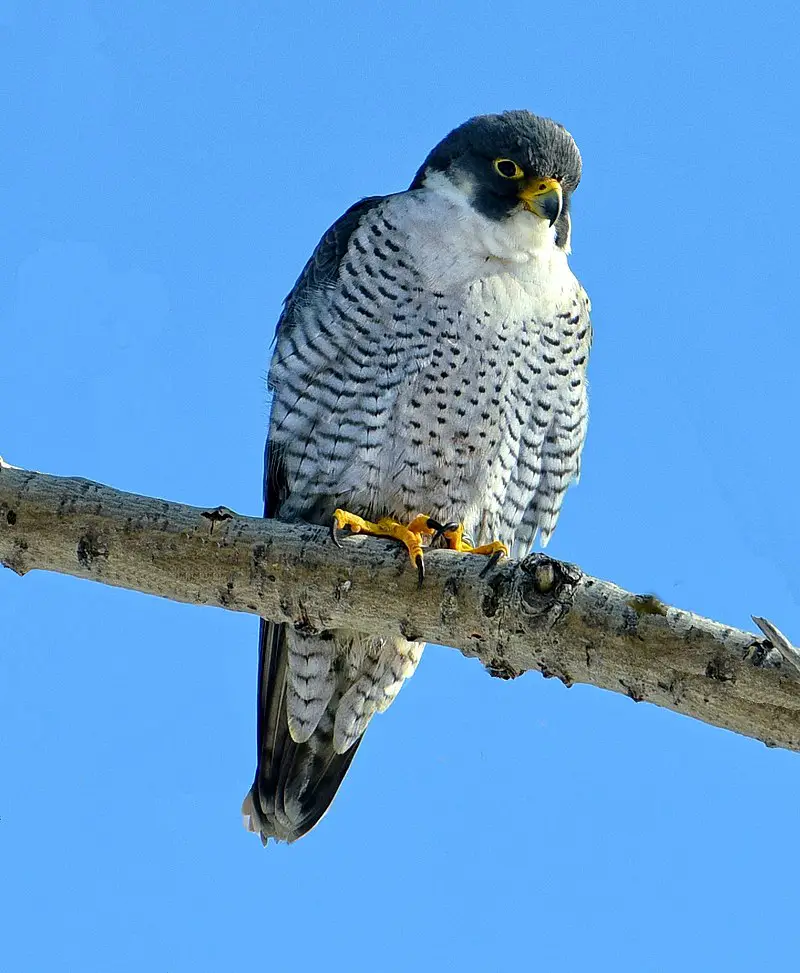
The Peregrine Falcon is a majestic bird of prey belonging to the family Falconidae. It has a blue-grey back, barred white underparts and black head making it easily recognizable.
This intelligent raptor is known for its incredible speed reaching over 320 km/h (200 mph) during hunting dives – one of the fastest animals in existence.
The peregrine falcon can be found around the world from Arctic tundra to tropical rainforests thriving with humans or in high alpine mountains far away from civilization.
With their beauty, power and adaptability they are an impressive species that have earned respect among many cultures throughout history as symbols of strength and endurance.Scientific classification:
| Kingdom | Animalia |
| Phylum | Chordata |
| Class | Aves |
| Order | Falconiformes |
| Family | Falconidae |
| Genus | Falco |
| Species | F. peregrinus |
2. American Kestrel
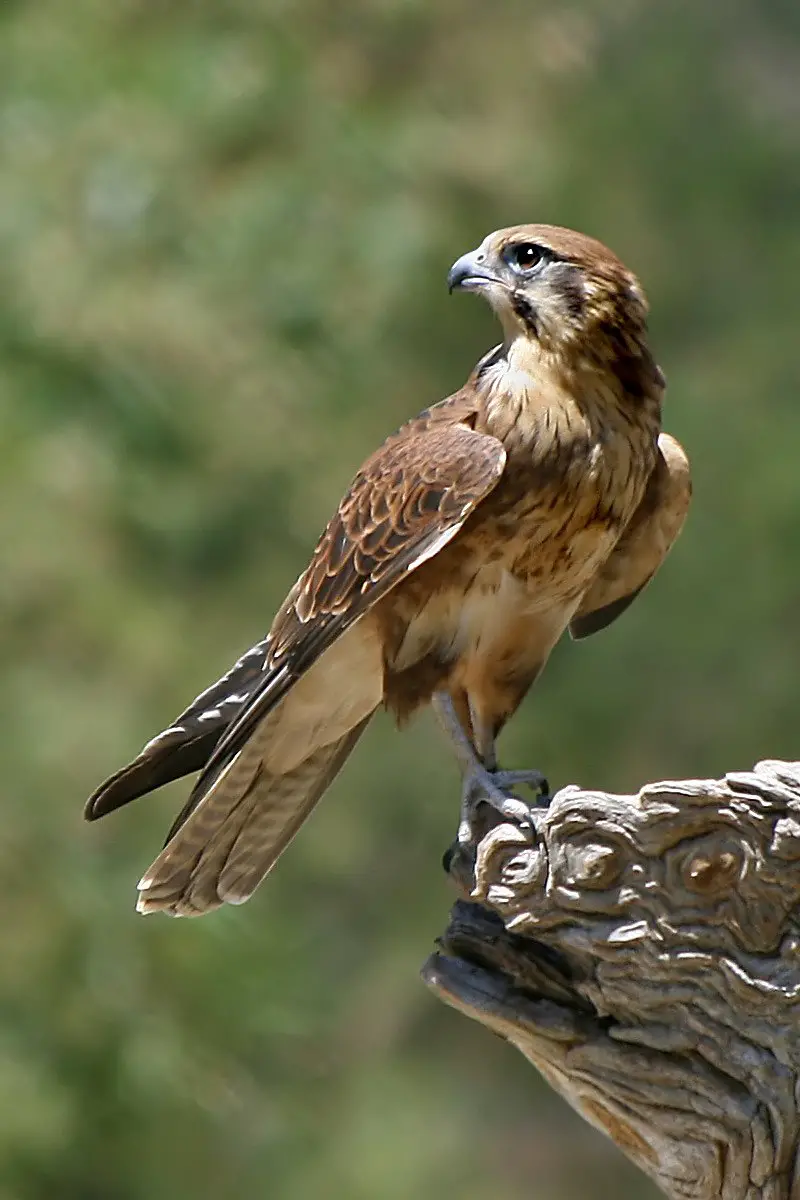
Falcons are majestic birds of prey found in almost all parts of the world, except Antarctica. They have long, slender wings that allow them to fly swiftly and change directions quickly.
As adults they feed on small animals such as mice and insects, but when young their diet consists mainly of carrion or food provided by their parents.
Falcons use a range of techniques for hunting including hovering high up above potential prey before diving down at great speed to catch it during flight.
Additionally they also ambush unsuspecting victims from concealed perches close to the ground.
These remarkable hunters can even take advantage of thermal currents rising off warm surfaces like roads which give them an extra boost while flying.Scientific classification:
| Kingdom | Animalia |
| Phylum | Chordata |
| Class | Aves |
| Order | Falconiformes |
| Family | Falconidae |
| Subfamily | Falconinae |
| Genus | Falco Linnaeus, 1758 |
3. Merlin
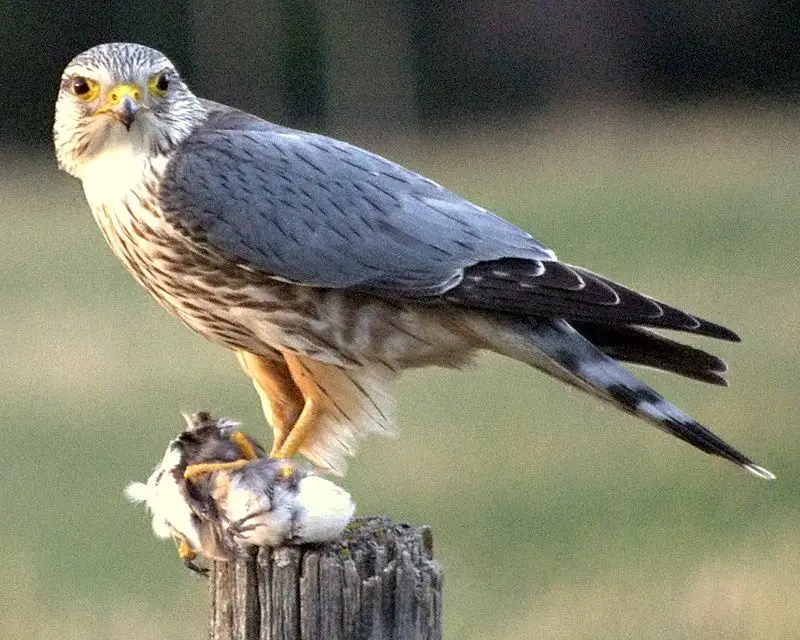
The Merlin is a small species of falcon found in the Northern Hemisphere. It has many subspecies across North America and Eurasia, and was once known as a Pigeon Hawk in North America.
Merlins breed mainly during summer months but some migrate to subtropical or northern tropical regions for winter season.
Males have wingspans ranging between 53-58 centimeters while females have slightly larger wingspan of 60-65 centimeters.
These birds are powerful fliers with fast aerial pursuits that can reach up to 50 mph.
Their diet consists mainly of insects, small mammals and other small birds which they hunt using their keen vision from high altitudes followed by swift dives down towards its prey at incredible speeds.
The Merlin continues to be an iconic symbol amongst bird enthusiasts due to its majestic beauty despite facing habitat loss around the world due to human activities such as deforestation and urbanization.Scientific classification:
| Kingdom | Animalia |
| Phylum | Chordata |
| Class | Aves |
| Order | Falconiformes |
| Family | Falconidae |
| Genus | Falco |
| Species | F. columbarius |
Also Featured In: Most Common Scotland Birds, Shetland Islands Birds You Should Know
4. Gyrfalcon
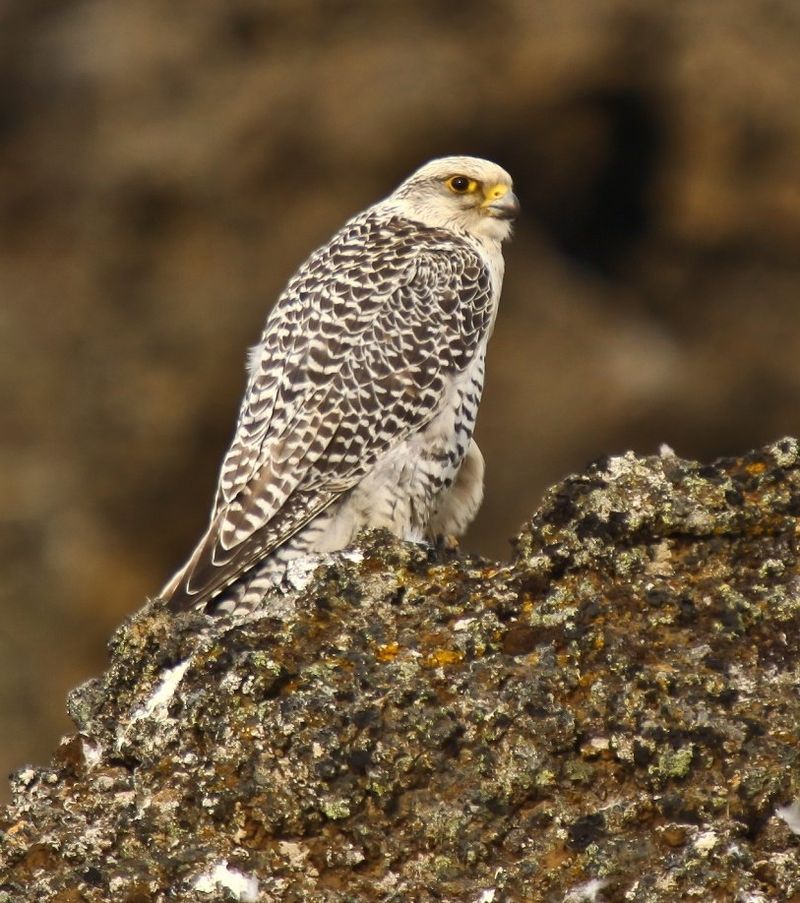
Gyrfalcon is the largest of all falcon species and a majestic bird of prey. It breeds in Arctic coasts, tundra areas, islands of northern North America and Eurosiberian regions.
Gyrfalcons are mainly resident birds but some may wander away from their breeding grounds during winter season or after mating period ends.
These beautiful raptors can be seen in white, dark gray/black and brown colors depending upon subspecies they belong to.
They have powerful wings that help them fly at high speeds while hunting for food like ptarmigans, ducks etc.,They also possess sharp vision which helps them spot small mammals even when they are miles away.
Though gyrfalkons’ population has decreased due to human interference on their habitats yet these magnificent creatures still remain an important part of our ecosystem providing us with ample opportunities to get close to nature’s beauty.Scientific classification:
| Kingdom | Animalia |
| Phylum | Chordata |
| Class | Aves |
| Order | Falconiformes |
| Family | Falconidae |
| Genus | Falco |
| Subgenus | Hierofalco |
| Species | F. rusticolus |
Also Featured In: Birds that Live in Greenland, Tundra Birds
5. Prairie Falcon
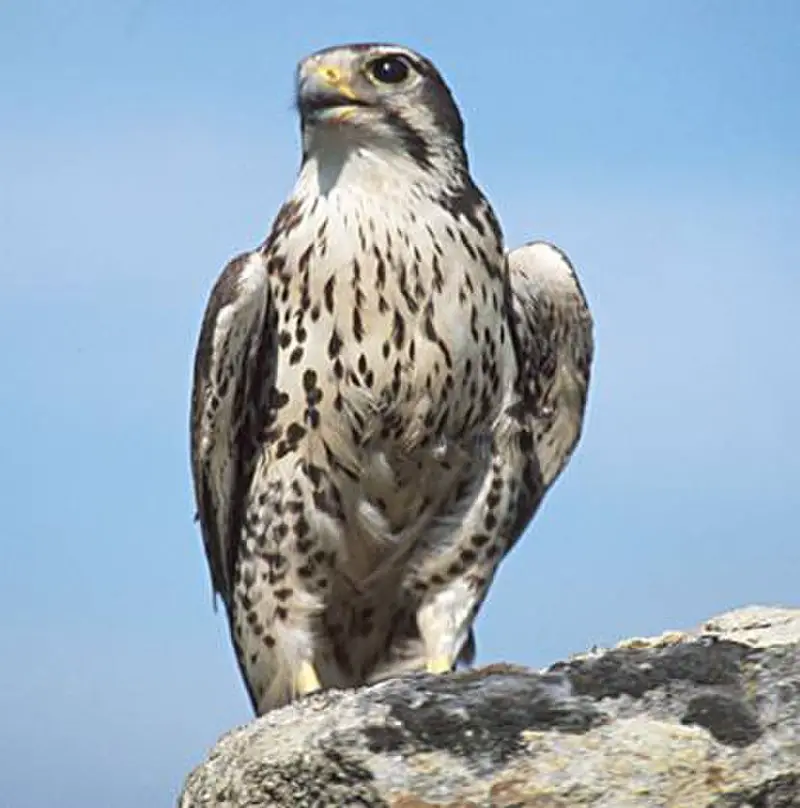
The Prairie Falcon is a distinct species of medium-large sized falcon found in western North America. It has an average length of 40cm, wingspan of 1 meter and weighs around 720g.
Females tend to be larger than males typical for all falcons.
Although separate from the Peregrine Falcon, they share many similarities such as similar coloring on their back and shoulders with dark spots on light brown feathers which helps them blend into the environment while hunting prey like small birds or rodents over open areas like grasslands or deserts.
They are also known to fly extremely fast reaching speeds up to 80 miles per hour.Scientific classification:
| Kingdom | Animalia |
| Phylum | Chordata |
| Class | Aves |
| Order | Falconiformes |
| Family | Falconidae |
| Genus | Falco |
| Species | F. mexicanus |
Also Featured In: Birds that Live in the Deserts, Common Birds in Alberta
6. Common Kestrel
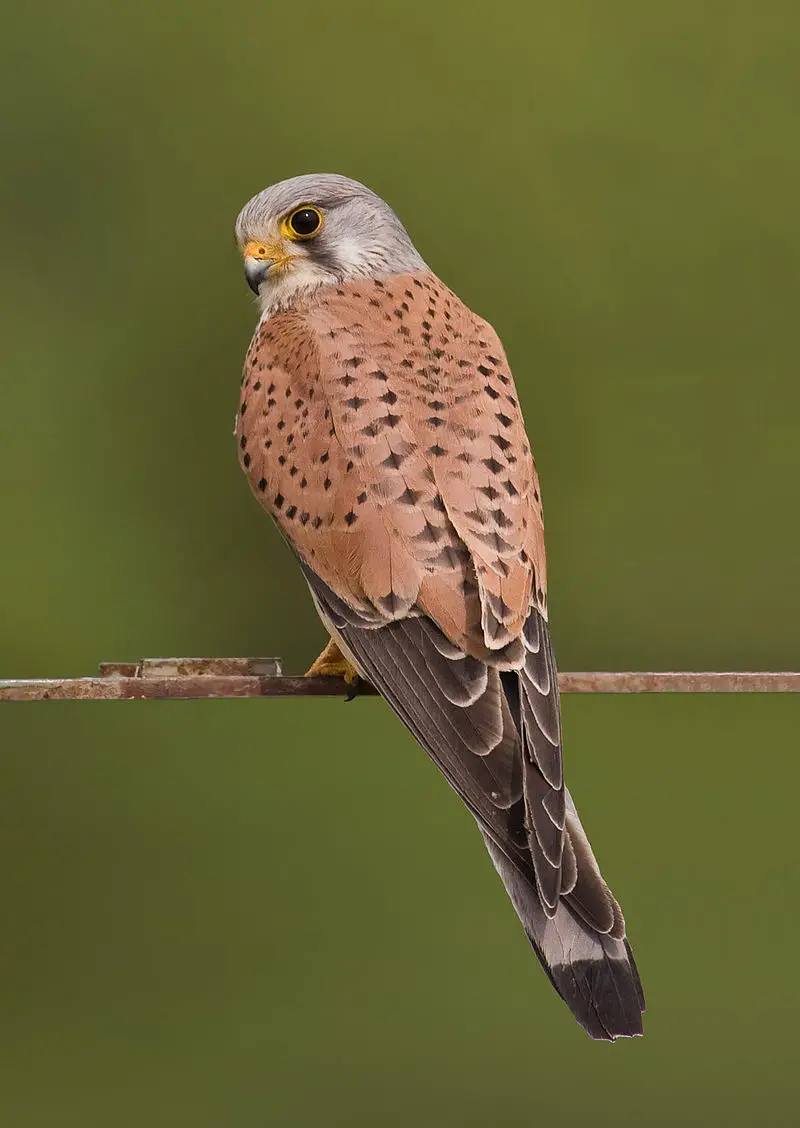
The Common Kestrel is a species of bird belonging to the kestrel group of Falconidae. It can be found in Europe, Asia and parts of Africa, though it is most commonly seen in the United Kingdom where it’s simply referred to as “Kestrel”.
This falcon has powerful talons and exceptional vision which makes them adept hunters who feed on small mammals such as voles or mice.
They are also renowned for their hovering flight – they will hover up high and scan with amazing accuracy below until they spot prey beneath them.
The beautiful plumage on this raptor varies from country to country but generally consists of shades ranging from grey-browns through chestnut reds with tawny hues around its face area.Scientific classification:
| Kingdom | Animalia |
| Phylum | Chordata |
| Class | Aves |
| Order | Falconiformes |
| Family | Falconidae |
| Genus | Falco |
| Species | F. tinnunculus |
7. Grey Falcon
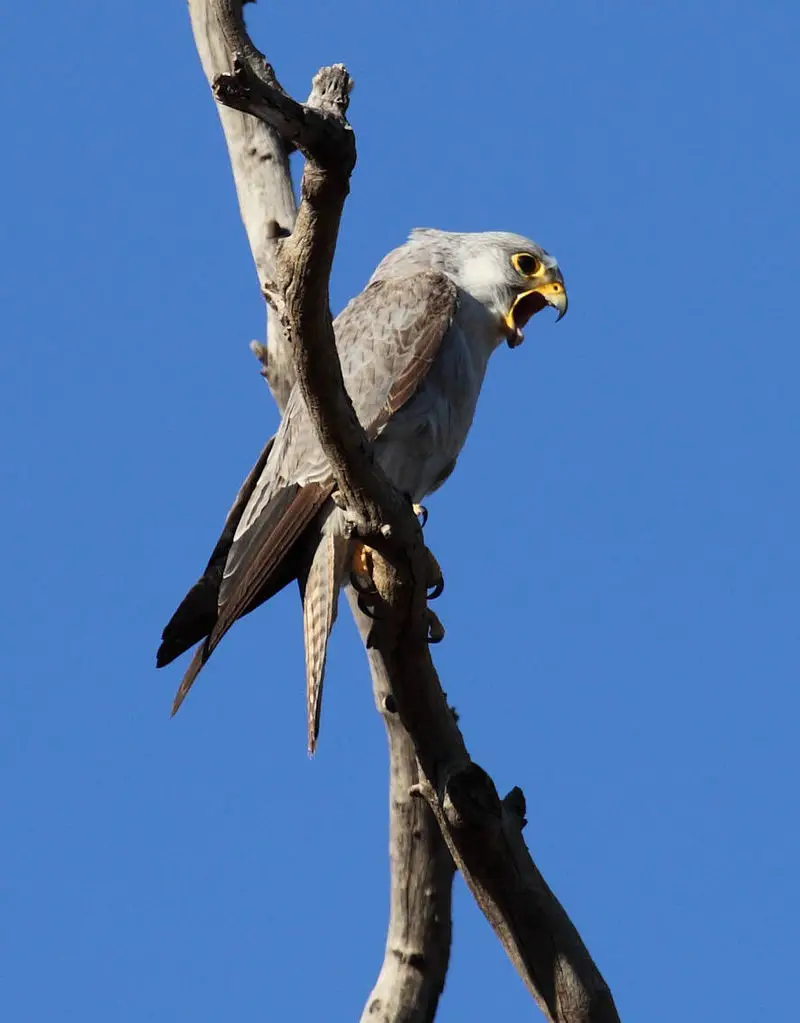
The Grey Falcon is a medium-sized species of Falco native to Australia, and one of its rarest raptors. It has been classified as Vulnerable due to its scarcity throughout the country.
First described by John Gould in 1841, based on a specimen found in York, Western Australia provided by pastoralist Lockier Burges.
The grey falcon usually inhabits open habitats such as semi-arid plains or grasslands with scattered trees, where it nests on tall shrubs or rock ledges near water sources while hunting for small birds and mammals from above using impressive aerial acrobatics and speed dives.
Conservation efforts are underway to ensure the survival of this beautiful bird which plays an important role within their ecosystem.Scientific classification:
| Kingdom | Animalia |
| Phylum | Chordata |
| Class | Aves |
| Order | Falconiformes |
| Family | Falconidae |
| Genus | Falco |
| Species | F. hypoleucos |
Also Featured In: Native Birds Of Mackay,
8. Brown Falcon
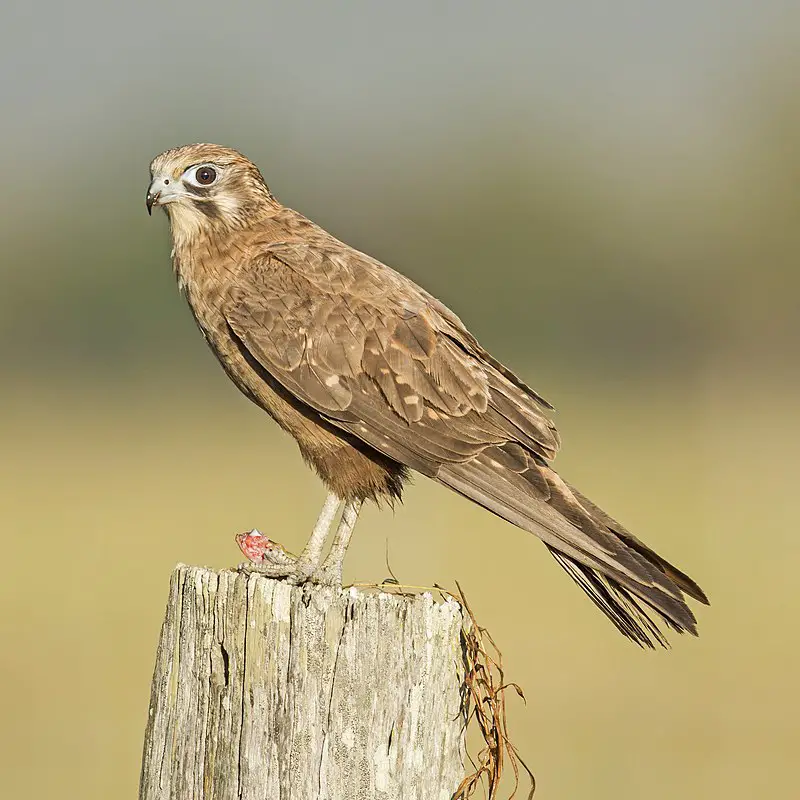
The Brown Falcon is a majestic bird native to Australia and New Guinea. It has a multitude of plumage morphs, with the primary difference being between pale and dark morph birds.
The light-colored ones typically have white undersides with some streaking, while their darker counterparts usually feature entirely brown upper parts.
These large falcons are highly adaptable predators that hunt small animals for food such as rabbits, snakes or lizards.
They also feed on carrion and grains during wintertime when prey becomes scarce. Thanks to its impressive flying abilities, it can quickly soar over vast distances in search of sustenance or mates by relying on powerful thermals ascending from the ground below them.Scientific classification:
| Kingdom | Animalia |
| Phylum | Chordata |
| Class | Aves |
| Order | Falconiformes |
| Family | Falconidae |
| Genus | Falco |
| Species | F. berigora |
Also Featured In: Birds that Live around Brisbane, Birds of Tasmania
9. Aplomado Falcon
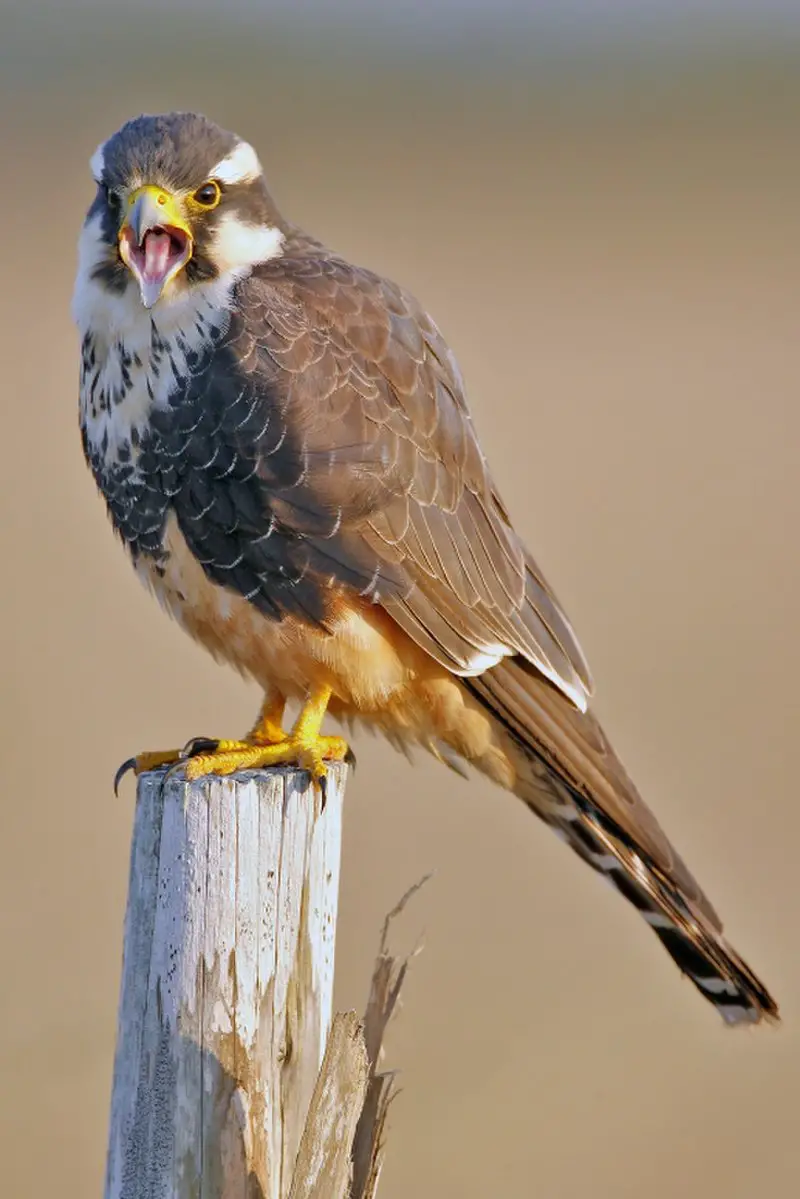
The Aplomado Falcon is a medium-sized raptor that can be found in the Americas. It has a beautiful slate grey and white plumage, with dark barring on its wings and tail.
Its long pointed wings make it an agile hunter of small birds and rodents, which it captures by flying quickly at low altitudes or swooping down from high perches.
The species’ largest range extends through South America but not into the deep Amazon Basin regions.
This falcon is sometimes mistaken for the Hobby due to their similar shape; however, they are two distinct species with different hunting behaviours and diets.Scientific classification:
| Kingdom | Animalia |
| Phylum | Chordata |
| Class | Aves |
| Order | Falconiformes |
| Family | Falconidae |
| Genus | Falco |
| Species | F. femoralis |
10. Black Falcon
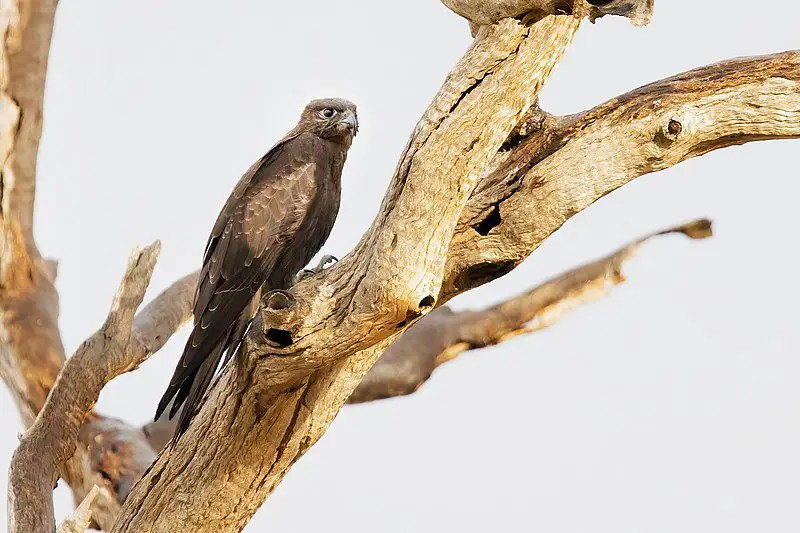
The Black Falcon is an iconic bird of Australia and one of the most under-studied falcons in the country. It can be found all over mainland states and territories, but very little research has been done on it so far.
This magnificent raptor measures around 50 cm long with a wingspan between 90 to 105cm; its feathers are black overall except for some pale grey patches underneath.
Its diet consists mainly of small birds, lizards, insects, mammals and carrion which it hunts by soaring above open ground or hovering over water bodies.
The species is currently not endangered nor threatened but may become more vulnerable as habitat destruction continues across Australia due to urbanization and climate change.Scientific classification:
| Kingdom | Animalia |
| Phylum | Chordata |
| Class | Aves |
| Order | Falconiformes |
| Family | Falconidae |
| Genus | Falco |
| Species | F. subniger |
11. Spotted Kestrel
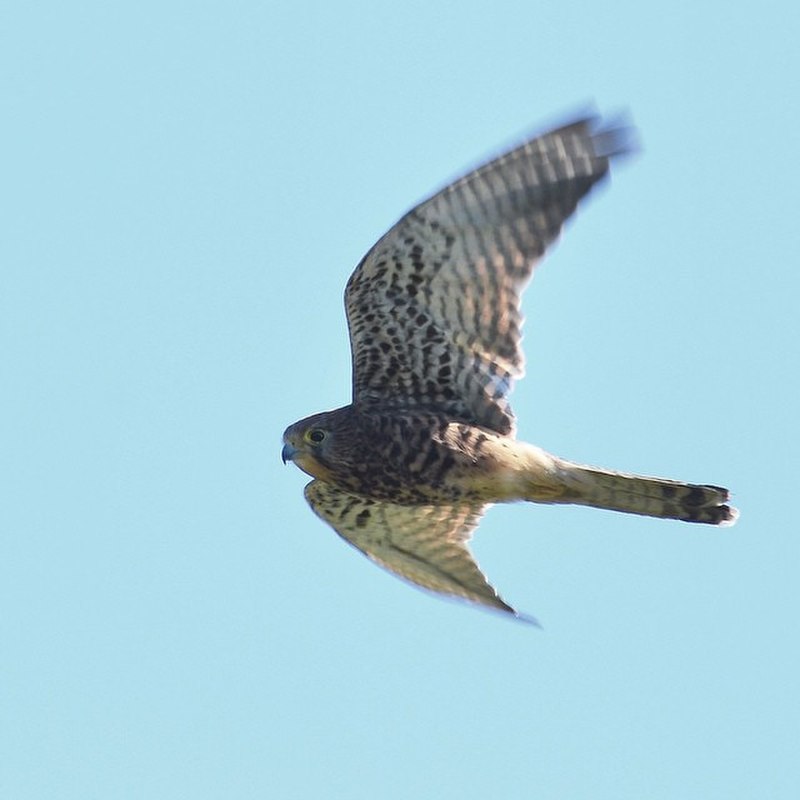
The spotted kestrel, or Moluccan Kestrel, is a species of bird that inhabits grasslands with scattered trees and lightly wooded areas.
It can be found in the Wallacea and Java regions as well as along logging roads where it occasionally penetrates deeper into forests.
They are also known to live within clearings in forested areas. This small raptor has distinctive yellow-brown plumage with black spots on its back and tail feathers which help camouflage them against their surroundings when perched among foliage.
Its diet primarily consists of insects, reptiles such as lizards and rodents like miceScientific classification:
| Kingdom | Animalia |
| Phylum | Chordata |
| Class | Aves |
| Order | Falconiformes |
| Family | Falconidae |
| Genus | Falco |
| Species | F. moluccensis |
Also Featured In: Birds in Sumba, Common Birds of Lombok
12. Saker Falcon
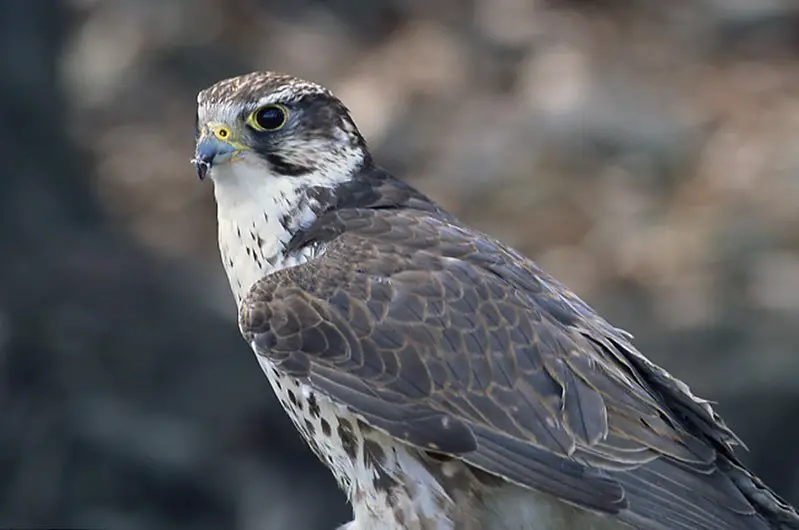
The saker falcon is a large species of falcon that is found across the Palearctic from central Europe all the way to Manchuria.
It typically migrates, except for in southern parts of its range where it winters in Ethiopia, Arabia, northern Pakistan and China.
This majestic bird has been designated as the national bird of Hungary, United Arab Emirates and Mongolia due to its beauty and gracefulness.
Its plumage can be brownish-grey or light grey with dark spots while they have bright yellow eyes which contrast their feathers beautifully.
They are also quite agile when flying at high speeds with wingspan ranging between 1-1.5 m long – perfect for soaring.Scientific classification:
| Kingdom | Animalia |
| Phylum | Chordata |
| Class | Aves |
| Order | Falconiformes |
| Family | Falconidae |
| Genus | Falco |
| Subgenus | Hierofalco |
| Species | F. cherrug |
13. Barbary Falcon
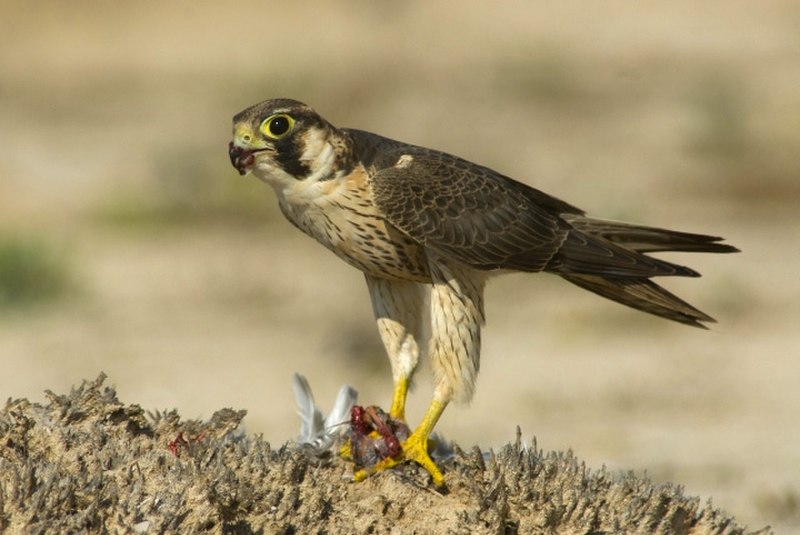
The Barbary falcon (Falco peregrinus pelegrinoides) is a medium-sized bird of prey typically found in semi-desert and dry open hills.
This agile hunter has the size of a crow, with an impressive wingspan that enables it to soar through the skies with great speed.
It mainly resides in areas ranging from the Canary Islands eastwards across North Africa, Middle East and Central Asia, usually nesting on cliff ledges or other high places.
Its diet consists mostly of small birds like pigeons or doves; however they also feed on small mammals such as bats and rodents too.
With its remarkable flying abilities and hunting prowess this majestic species continues to captivate people throughout its range making it an iconic symbol for many cultures over centuries now.Scientific classification:
| Kingdom | Animalia |
| Phylum | Chordata |
| Class | Aves |
| Order | Falconiformes |
| Family | Falconidae |
| Genus | Falco |
| Species | F. peregrinus |
| Subspecies | F. p. pelegrinoides |
Also Featured In: Birds of Lanzarote, Fuerteventura Island Birds You Need to See
14. Red-Necked Falcon
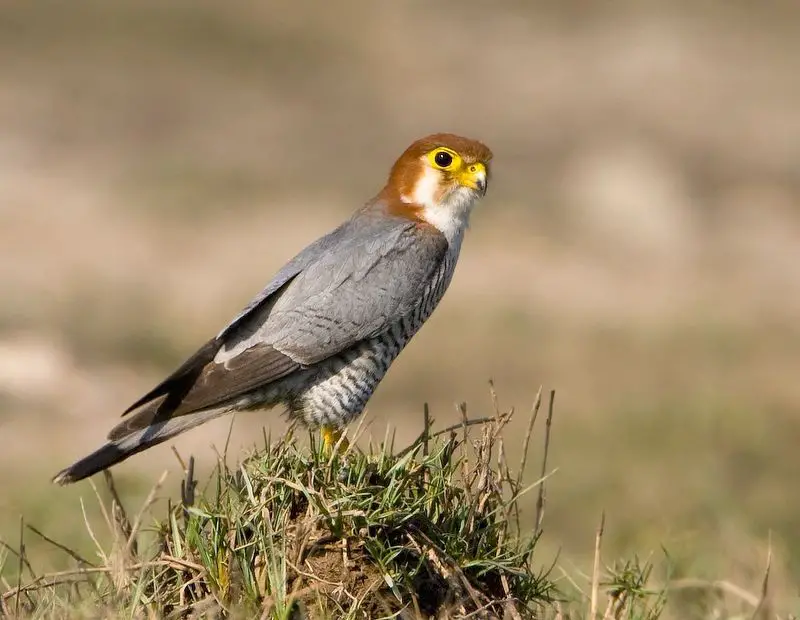
The Red-necked Falcon is a beautiful bird of prey found in two disjunct populations. This medium sized falcon has bluish grey wings and upper body, with the most distinguishing feature being its chestnut red cap which is accompanied by short chin straps that pass through each eye.
The primary feathers are black on its wings along with a single black band at the tip of its tail.
In India it can be seen flying over open country or near forest edges while in Africa they inhabit semi desert areas and savannahs as well as coastal habitats such as lagoons and estuaries.
They hunt during the day mostly for insects like grasshoppers, moths and butterflies but have also been known to take small birds too.Scientific classification:
| Kingdom | Animalia |
| Phylum | Chordata |
| Class | Aves |
| Order | Falconiformes |
| Family | Falconidae |
| Genus | Falco |
| Species | F. chicquera |
Also Featured In: Delhi Birds You Need to See,
15. Mauritius Kestrel
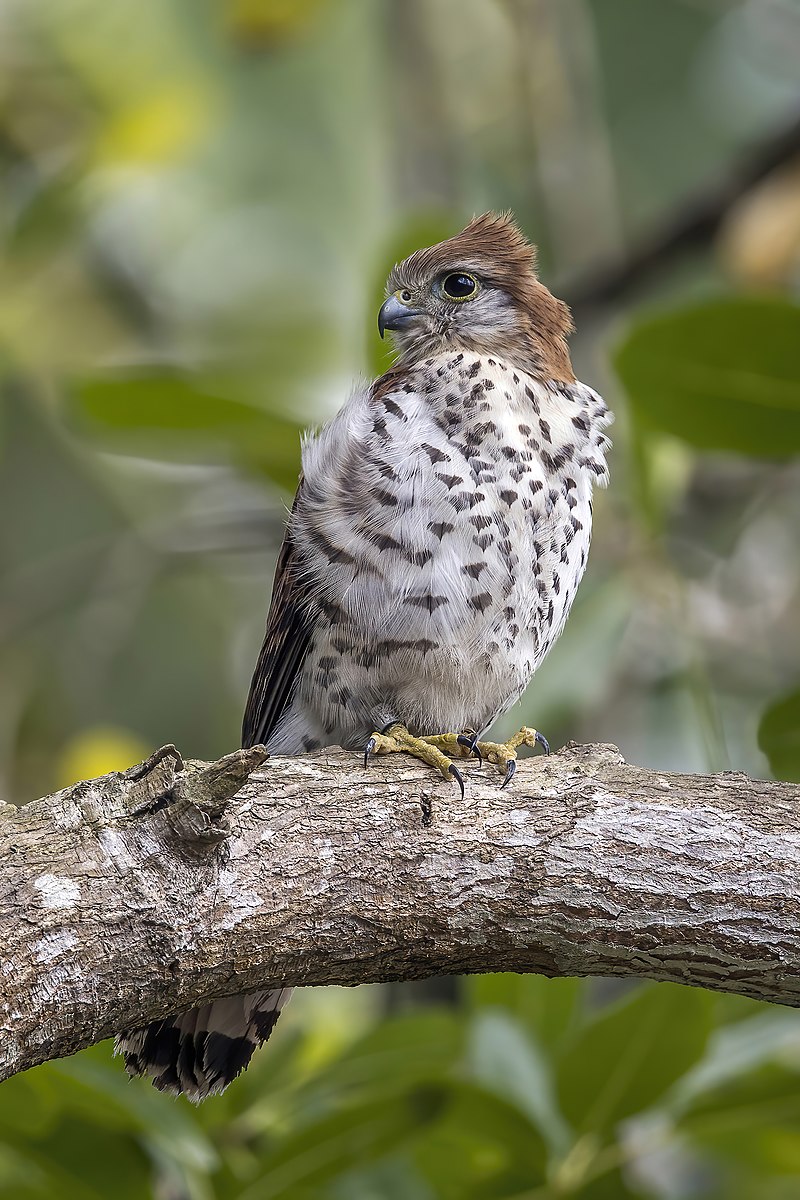
The Mauritius kestrel is a bird of prey endemic to the forests of Mauritius. It belongs to the family Falconidae and evolved into a distinct species during Late Pliocene, colonizing its island home.
This small raptor has bright chestnut upperparts with black spots and whitish underparts barred in dark brown; it has yellow-orange facial skin, legs and feet.
Its diet consists mainly on lizards, insects, grasshoppers as well as mice or young birds when available.
The population was dangerously low at one point but thanks to conservation efforts their numbers have increased significantly over recent years making them no longer endangered.Scientific classification:
| Kingdom | Animalia |
| Phylum | Chordata |
| Class | Aves |
| Order | Falconiformes |
| Family | Falconidae |
| Genus | Falco |
| Species | F. punctatus |
16. New Zealand Falcon

Falcons are majestic birds of prey found in almost all parts of the world, except Antarctica. They have long, slender wings that allow them to fly swiftly and change directions quickly.
As adults they feed on small animals such as mice and insects, but when young their diet consists mainly of carrion or food provided by their parents.
Falcons use a range of techniques for hunting including hovering high up above potential prey before diving down at great speed to catch it during flight.
Additionally they also ambush unsuspecting victims from concealed perches close to the ground.
These remarkable hunters can even take advantage of thermal currents rising off warm surfaces like roads which give them an extra boost while flying.Scientific classification:
| Kingdom | Animalia |
| Phylum | Chordata |
| Class | Aves |
| Order | Falconiformes |
| Family | Falconidae |
| Subfamily | Falconinae |
| Genus | Falco Linnaeus, 1758 |
17. Red-Footed Falcon
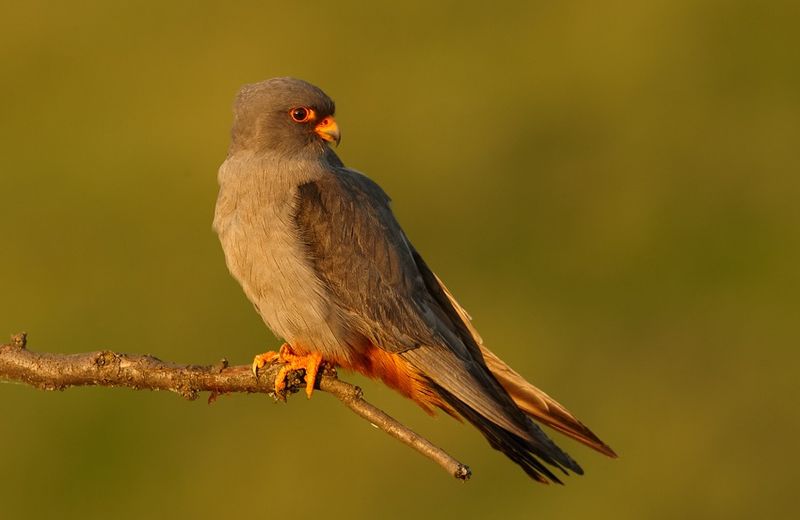
The Red-footed Falcon is a majestic bird of prey belonging to the Falconidae family. Found mainly in eastern Europe and Asia, numbers are unfortunately dwindling due to habitat loss and hunting.
This species migrates south for winter, with many birds making their way as far west as western Europe. In August 2004 one was even spotted in Britain; quite an impressive feat.
They have a striking plumage consisting of rich chestnut red legs contrasting against its grey wings and white underbelly – lending itself well to identification from afar.
The diet of this raptor mostly consists of small mammals such as mice or voles but it has also been known to feed on insects too.
A threatened species, conservation efforts must be made if we wish for generations after us to appreciate these beautiful falcons that soar across our skies.Scientific classification:
| Kingdom | Animalia |
| Phylum | Chordata |
| Class | Aves |
| Order | Falconiformes |
| Family | Falconidae |
| Genus | Falco |
| Species | F. vespertinus |
18. Australian Hobby
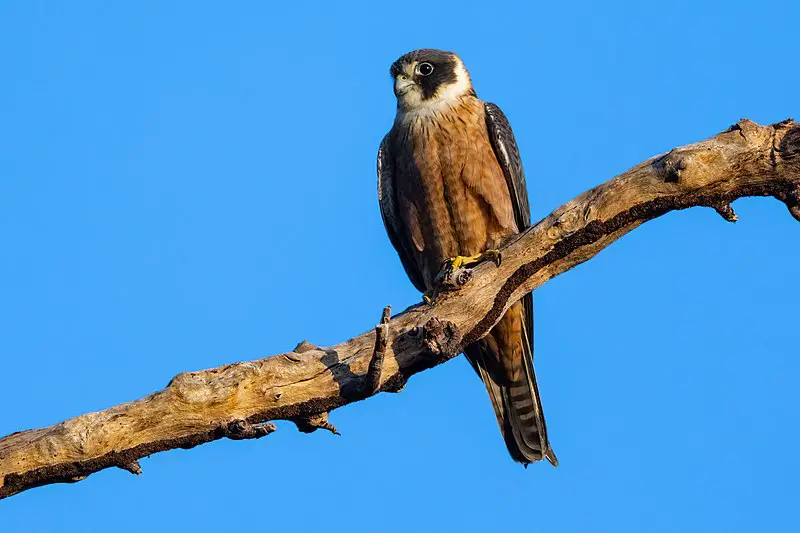
The Australian hobby is a small bird of prey found across Australia and its neighbouring countries. It has long primary wing feathers, which give it the scientific name Falco longipennis – meaning ‘long-winged’.
During migration season, members of this species can be seen on islands in Indonesia and New Guinea. The Australian hobby is mostly active during daylight hours but will sometimes hunt at night too.
Its diet consists mainly of insects such as dragonflies and grasshoppers, although some larger birds are also taken.
This adaptable predator inhabits both open areas like woodland clearings as well as densely populated urban environments where they take advantage of abundant food sources like city parks or gardens.Scientific classification:
| Kingdom | Animalia |
| Phylum | Chordata |
| Class | Aves |
| Order | Falconiformes |
| Family | Falconidae |
| Genus | Falco |
| Species | F. longipennis |
19. Amur Falcon
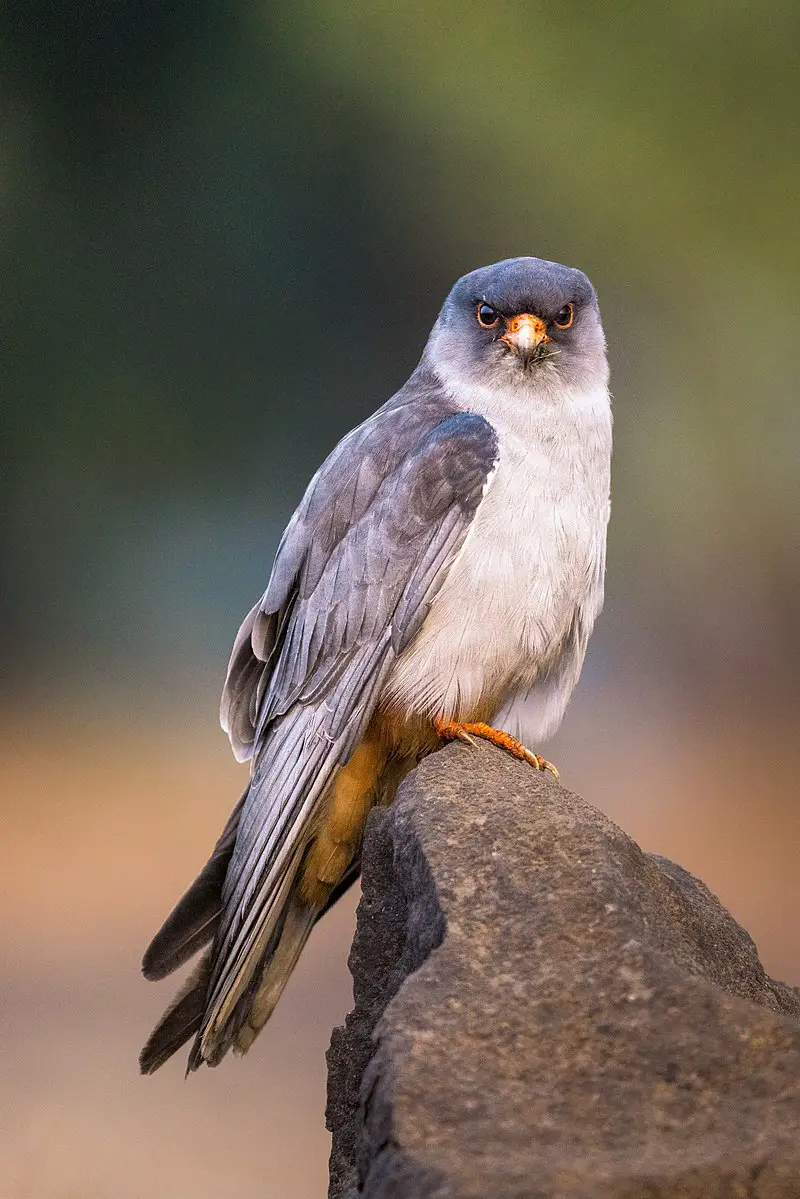
The Amur falcon is a beautiful bird of the falcon family, native to Siberia and parts of Northern China. Its plumage features dark sooty grey on its upperparts, with rufous thighs and vent.
In flight, it stands out with white wing linings contrasting against its dark wings feathers.
Each year it migrates in large flocks across India before flying over the Arabian Sea towards East Africa for wintering purposes.
It has been observed that these birds can fly up to 1000 miles per day during their long-distance migration.
This species have adapted well to human presence as they often use manmade structures such as transmission towers for roosting or nesting sites near villages like paddy fields where there’s an abundance of food sources like dragonflies and grasshoppers.Scientific classification:
| Kingdom | Animalia |
| Phylum | Chordata |
| Class | Aves |
| Order | Falconiformes |
| Family | Falconidae |
| Genus | Falco |
| Species | F. amurensis |
20. Bat Falcon
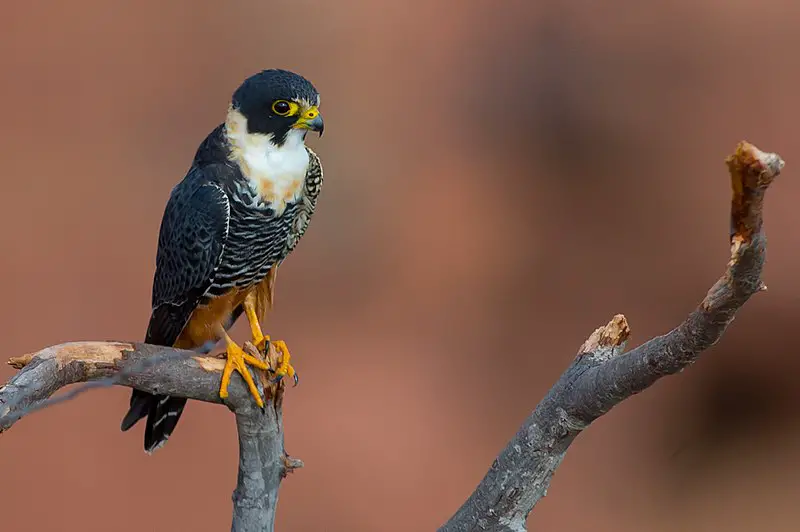
The Bat Falcon is a small falcon found in Mexico, Central and South America, as well as Trinidad. It was previously known as Falco albigularis but has since been renamed to its current name.
This bird of prey looks similar to the Orang-utan with its brownish-gray plumage and bright blue cere on top of their beaks. They are generally around 9 inches long with a wingspan reaching up to 20 inches across.
The Bat Falcons prefer open savanna or woodland habitats where they can hunt for insects or small birds during the day.
These birds rely heavily on flying insect populations which makes them vulnerable when these numbers drop due too environmental changes such climate change making it important that we protect this species from further endangerment by preserving suitable habitat types so they can continue living there happily.Scientific classification:
| Kingdom | Animalia |
| Phylum | Chordata |
| Class | Aves |
| Order | Falconiformes |
| Family | Falconidae |
| Genus | Falco |
| Species | F. rufigularis |
Also Featured In: Birds You’ll Find in South Texas , Puerto Vallarta Birds You Should Know
21. Lanner Falcon
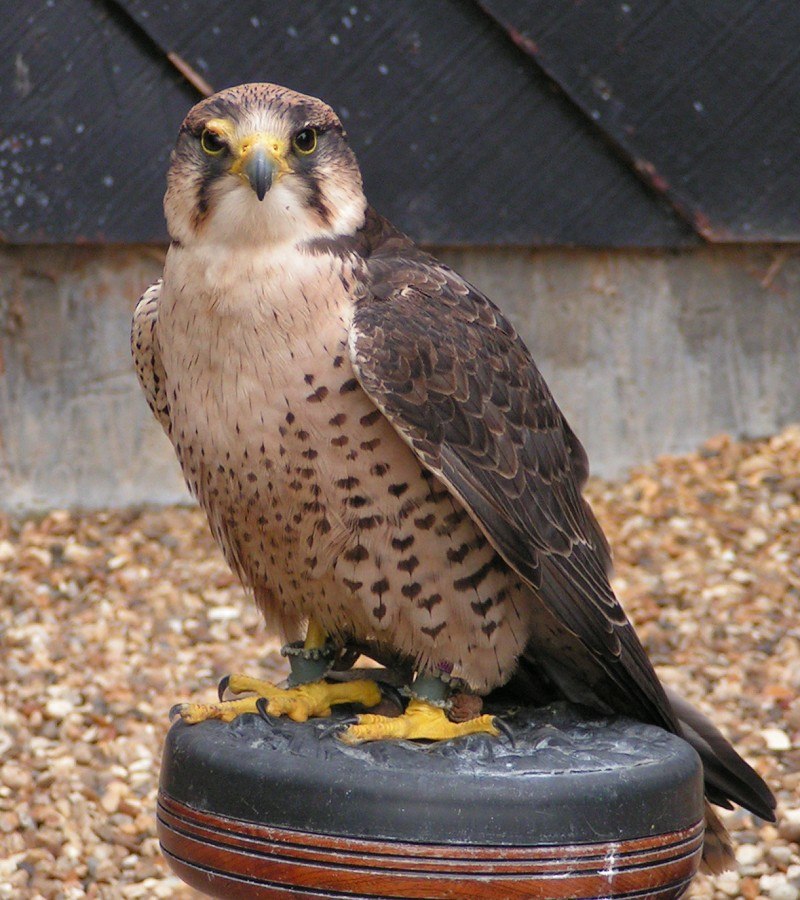
The Lanner falcon is a medium-sized bird of prey found throughout Africa, southeast Europe and parts of Asia. It has a wingspan up to 42 inches and is typically slate gray with chestnut accents on its upper body.
This majestic creature prefers open habitat such as grasslands or savannas providing them ample hunting opportunities for small birds, bats and even large insects.
The species was first described by Dutch zoologist Coenraad Jacob Temminck in 1825 under the scientific name Falco biarmicus.
Thanks to conservation efforts this magnificent raptor remains abundant in some regions today though it does face threats from loss of habitat due to human development activities as well as illegal trapping for use within the sport hunting industry.Scientific classification:
| Kingdom | Animalia |
| Phylum | Chordata |
| Class | Aves |
| Order | Falconiformes |
| Family | Falconidae |
| Genus | Falco |
| Subgenus | Hierofalco |
| Species | F. biarmicus |
22. Malagasy Kestrel
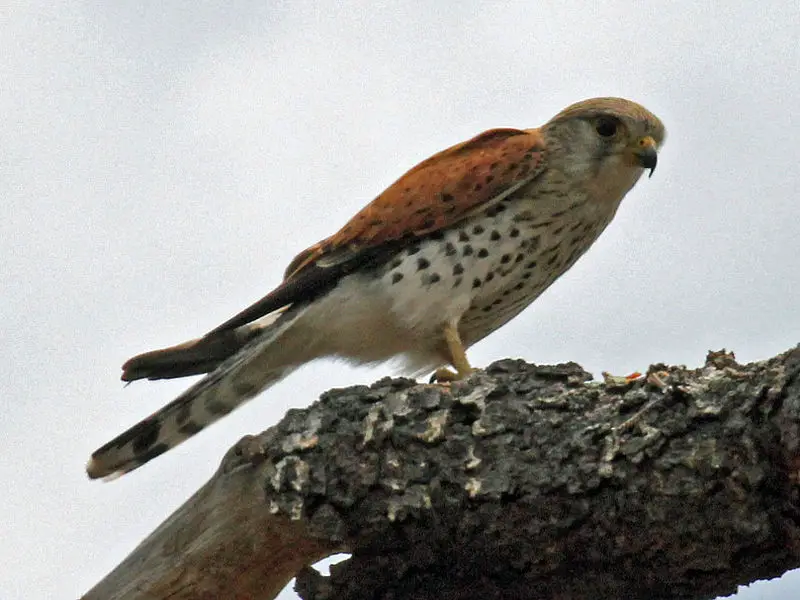
The Malagasy Kestrel is a small bird of prey found on the island of Madagascar, and at Aldabra. It has two subspecies with the race from Aldabra also called ‘Aldabra kestrel’.
The Malagasy Kestrel can be identified by its spotted black-and-white breast feathers and yellow legs. Its diet consists mostly of insects, lizards, frogs and other small creatures.
This species faces threats such as deforestation for logging or agriculture which destroys their habitat leading to population decline in some areas.
However conservation efforts have been made to protect this species from further endangerment including captive breeding programs and protected habitats where they are monitored regularly by local wildlife officials.Scientific classification:
| Kingdom | Animalia |
| Phylum | Chordata |
| Class | Aves |
| Order | Falconiformes |
| Family | Falconidae |
| Genus | Falco |
| Species | F. newtoni |
23. Lesser Kestrel
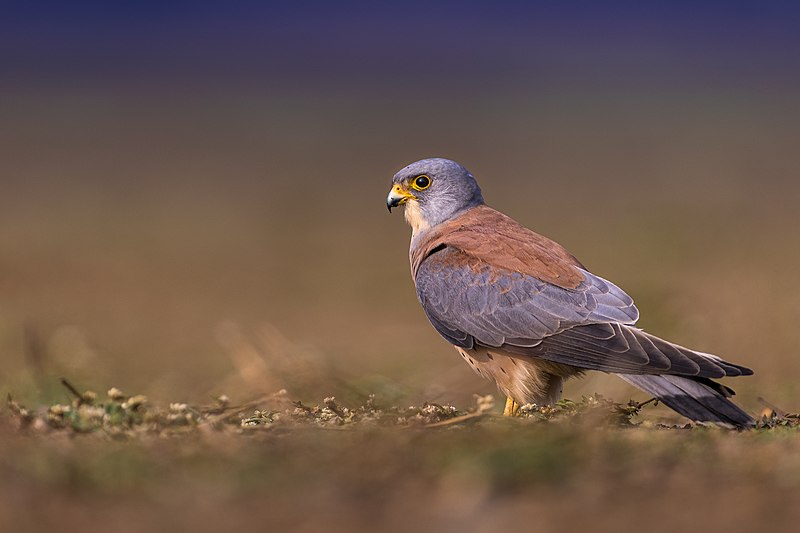
The Lesser Kestrel is a small falcon species that breeds in various regions of the Mediterranean, Afghanistan, Central Asia, China and Mongolia. During summer they migrate to Africa, Pakistan and even India or Iraq.
The population of this bird has been declining in its European range but it remains rare north of its breeding locations.
Its genus name “Falco” derives from Late Latin meaning sickle which describes their curved beak shape used for hunting prey like insects or lizards.
Their diet also consists mainly on seeds and grains as well as some fruits when available making them versatile hunters able to survive different climates where food may vary seasonally.Scientific classification:
| Kingdom | Animalia |
| Phylum | Chordata |
| Class | Aves |
| Order | Falconiformes |
| Family | Falconidae |
| Genus | Falco |
| Species | F. naumanni |
24. Nankeen Kestrel
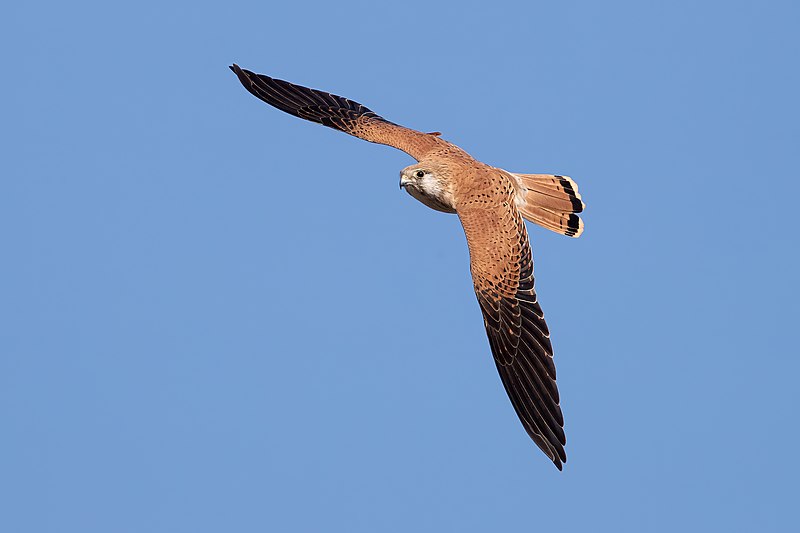
The nankeen kestrel is a small bird of prey native to Australia and New Guinea. Unlike many raptors, it does not rely on speed to capture its prey; instead, it perches in an exposed spot or hovers over fields and grasslands.
It belongs to the genus Falco which also includes other species such as peregrine falcons.
This bird typically has cinnamon-brown upperparts with dark wings and tail whilst its underside is usually pale buffish-white colouring with narrow black barring across the chest area.
Its diet consists mainly of insects but can include reptiles, amphibians, mice and even some birds among others depending on their availability within their habitat range.
The Nankeen Kestrel is an important part of our ecosystems providing essential services such as pest control for farmers by preying upon pests like locusts while also being a keystone species that influences surrounding habitats through predation or competition for resources amongst other animals.Scientific classification:
| Kingdom | Animalia |
| Phylum | Chordata |
| Class | Aves |
| Order | Falconiformes |
| Family | Falconidae |
| Genus | Falco |
| Species | F. cenchroides |
25. Oriental Hobby
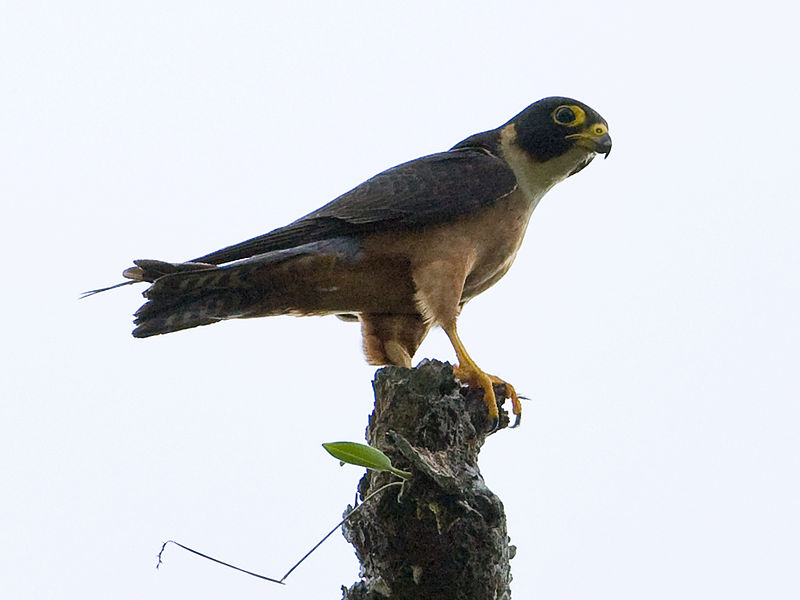
The Oriental Hobby is a species of falcon found across the northern parts of the Indian Subcontinent, eastern Himalayas and Indochina to Australasia.
It can reach up to 27-30 cm in length and has been observed as a vagrant from Malaysia.
This bird feeds mainly on insects and birds with rare instances where it catches bats too. Its coloring consists mostly of greyish brown above while its underside is light chestnut or buff tinged white or cream color with black spots along its belly area.
The male sports an additional patch of bluish slate above its tail which makes them easily distinguishable from female counterparts who lack this feature instead having gray barring at their tails end.Scientific classification:
| Kingdom | Animalia |
| Phylum | Chordata |
| Class | Aves |
| Order | Falconiformes |
| Family | Falconidae |
| Genus | Falco |
| Species | F. severus |
Also Featured In: Birds that Migrate to Sri Lankan,
26. Seychelles Kestrel
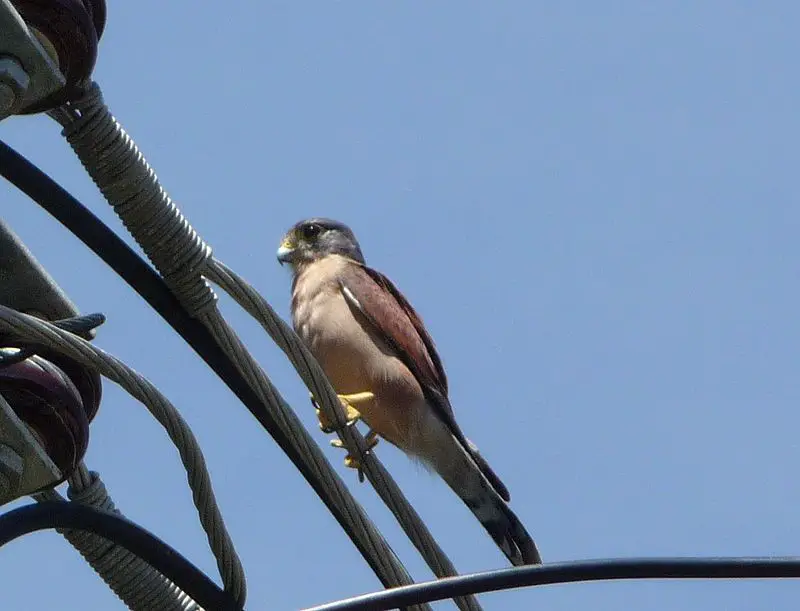
The Seychelles kestrel is a small bird of prey endemic to the Seychelles Islands. It has an unmistakable loud, shrill call in its native Creole language, known as the “katiti”.
Measuring 18–23 cm long with a wingspan of 40–45 cm and fairly short rounded wings, it is the smallest of all kestrels.
The adult birds have two color morphs – one brownish-gray above and white below; while others are darker overall but still display distinct mottling on their backs.
Both sexes have similar plumage patterns and black barring on their tail feathers. They feed primarily insects, lizards or other small vertebrates that they catch by hovering over open areas before swooping down for capture.
However they will also take advantage of available food sources such as garbage dumps around human settlements or dead fish washed up along coastlines during low tide periods.
Despite being listed near threatened due to habitat destruction caused by humans, conservation efforts are helping populations stay stable in recent years giving hope for this unique species’ future survival.Scientific classification:
| Kingdom | Animalia |
| Phylum | Chordata |
| Class | Aves |
| Order | Falconiformes |
| Family | Falconidae |
| Genus | Falco |
| Species | F. araeus |
27. African Hobby
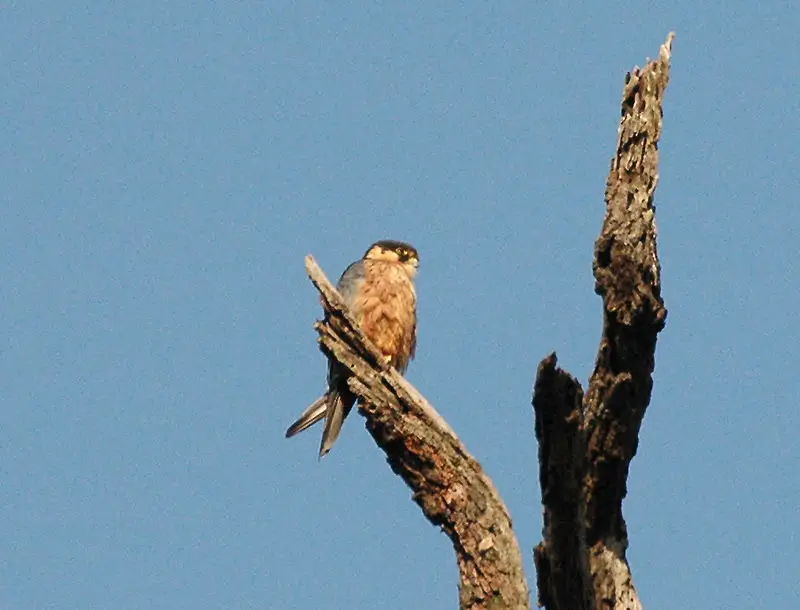
The African hobby is a small, slim bird of prey belonging to the Falconidae family. It has blackish upperparts and deep rufous underparts with a rufous cheek, nape and throat; at close range one can see black streaks on its throat and flanks.
Its facial skin and feet are yellow, while juvenile birds appear browner above with heavier streaking on their undersides which appears paler against the cheeks.
This species inhabits open grasslands in tropical regions where it feeds mainly on insects or bats caught in flight during night time foraging sessions.
They build nests out of twigs lined with softer materials like leaves or feathers, typically near cliffs or tree cavities but sometimes also using man-made structures such as bridges or buildings.
The African Hobby is considered vulnerable due to habitat destruction by humans yet still remains relatively common throughout much of Africa south of the Sahara desert.Scientific classification:
| Kingdom | Animalia |
| Phylum | Chordata |
| Class | Aves |
| Order | Falconiformes |
| Family | Falconidae |
| Genus | Falco |
| Species | F. cuvierii |
28. Greater Kestrel
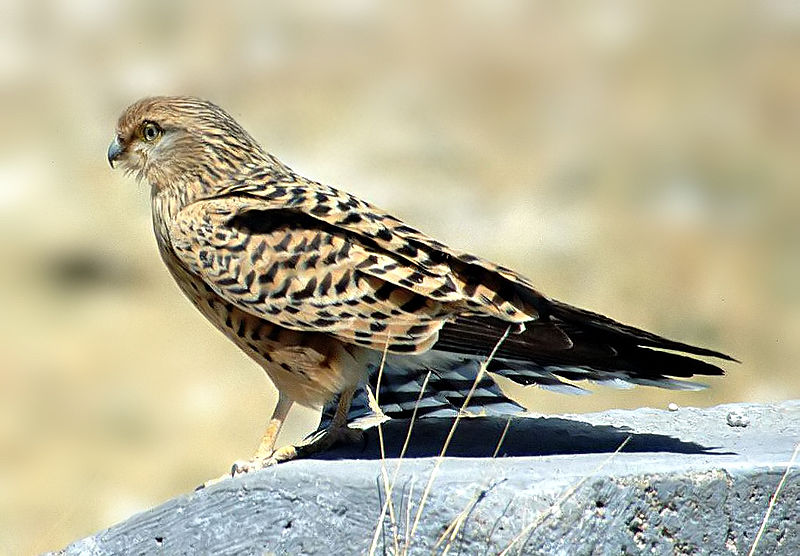
The Greater Kestrel, a large bird of prey from the Falconidae family, is found in open country throughout southern and eastern Africa.
It has mainly pale rufous plumage above and below with black barring on its back, upperwing and flanks.
Its breast has dark streaks while its head is streaked buff-brown with white eyes – hence it’s name; White-eyed Kestrel.
These birds are primarily carnivorous eating small mammals such as rodents, lizards or insects which they catch either by hovering high up or perched atop tall trees.
They also take advantage of human settlements to supplement their diet when food becomes scarce during harsher seasons.
Historically these birds were used for falconry but now they are increasingly threatened due to habitat loss caused by humans across their range making conservation efforts all the more important if we wish to ensure this majestic species will continue flying our skies for generations to come.Scientific classification:
| Kingdom | Animalia |
| Phylum | Chordata |
| Class | Aves |
| Order | Falconiformes |
| Family | Falconidae |
| Genus | Falco |
| Species | F. rupicoloides |
29. Grey Kestrel
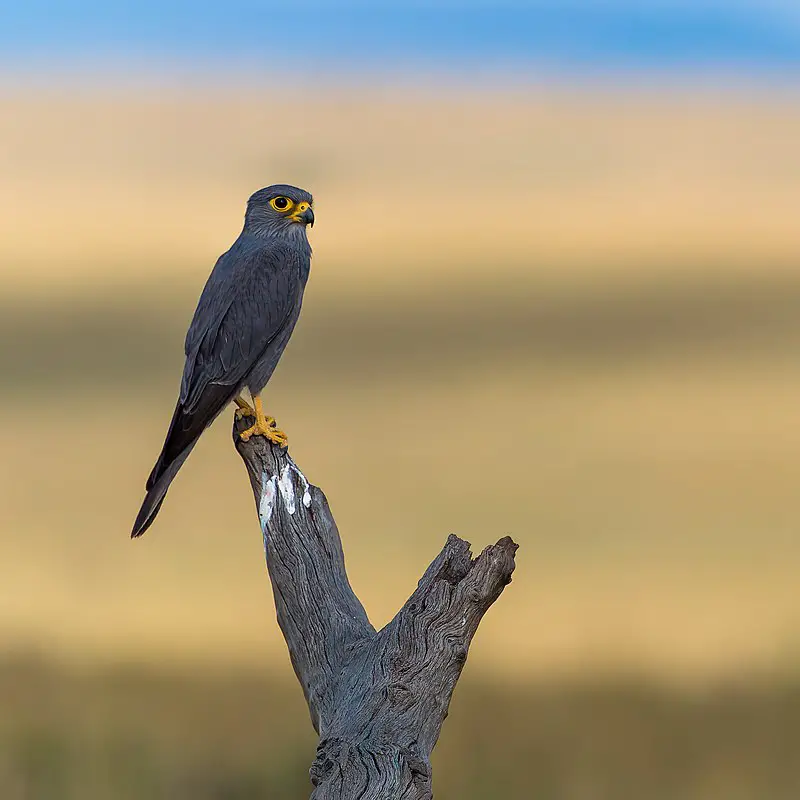
The Grey Kestrel is a small bird of prey native to Africa, belonging to the falcon family Falconidae. It has a large, flat-topped head and short wings that don’t reach past its tail when resting.
Measuring 28–33 cm in length with greyish-brown upperparts and pale underparts, it can be distinguished by its reddish eyes and yellow bill.
Its diet consists mainly of insects but also includes small rodents or birds which are caught on the ground or plucked from trees while hovering above them.
During breeding season they construct their nests on ledges of cliffs or buildings close to open fields where food is abundant for hunting purposes.
In areas where water resources are scarce these birds rely heavily on drinking dew drops off vegetation during early morning hours as an alternative way to hydrate themselves .Scientific classification:
| Kingdom | Animalia |
| Phylum | Chordata |
| Class | Aves |
| Order | Falconiformes |
| Family | Falconidae |
| Genus | Falco |
| Species | F. ardosiaceus |
30. Dickinson’s Kestrel
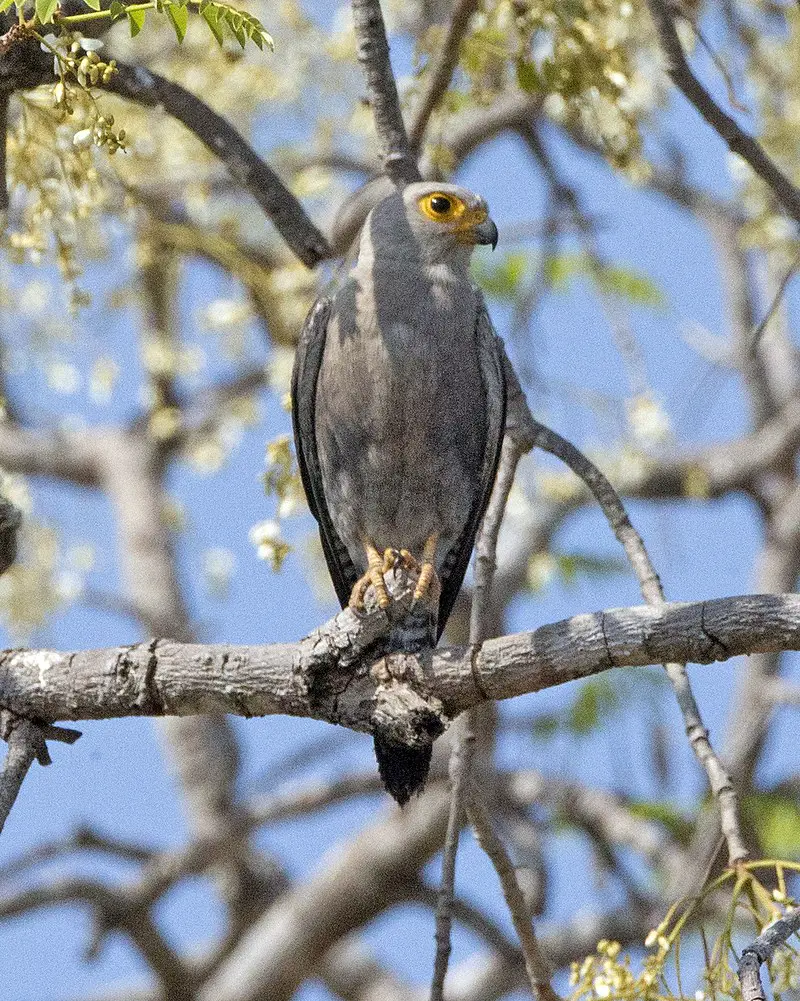
The Dickinson’s kestrel is a small, handsome falcon found in southern and eastern Africa. It has white plumage on the upperparts with black barring, rusty-red wings and tail feathers, and a distinctive white rump that gives it its alternate name of White-rumped Kestrel.
The head is pale grey while the underparts are streaked orange-brown. Its diet consists mainly of insects like grasshoppers but they will also take birds up to thrush size as well as reptiles or rodents when available.
They usually hunt from perches overlooking open areas such as savannas but can be seen hovering over fields hunting for prey too.
Though their population numbers remain stable now due to conservation efforts after being declared endangered in 2001 by BirdLife International, these beautiful raptors still face threats from habitat destruction and human disturbance so we must continue to protect them where possible.Scientific classification:
| Kingdom | Animalia |
| Phylum | Chordata |
| Class | Aves |
| Order | Falconiformes |
| Family | Falconidae |
| Genus | Falco |
| Species | F. dickinsoni |
31. Banded Kestrel
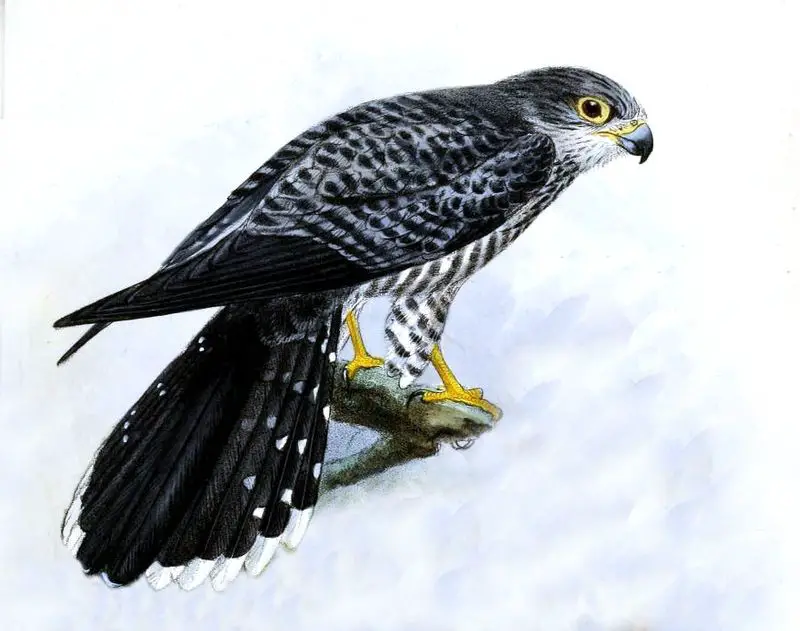
The Banded Kestrel is a bird of prey endemic to Madagascar and belongs to the Falconidae family. It measures 27-30 cm long, has barred underparts and a pale facial stripe with black moustache on both sides.
Its wings are pointed while its tail feathers are banded dark brown and white in color. The upper parts of their body is mostly greyish-brown but they have some reddish barring too.
They feed mainly on small reptiles such as lizards, amphibians like frogs, insects like locusts as well as fruits when available near forests or woodlands where they usually reside in pairs or alone during breeding season between November – April.
During this period males display courtship behavior by flying above its partner while calling out loudly before finally mating together afterwards.Scientific classification:
| Kingdom | Animalia |
| Phylum | Chordata |
| Class | Aves |
| Order | Falconiformes |
| Family | Falconidae |
| Genus | Falco |
| Species | F. zoniventris |
32. Sooty Falcon
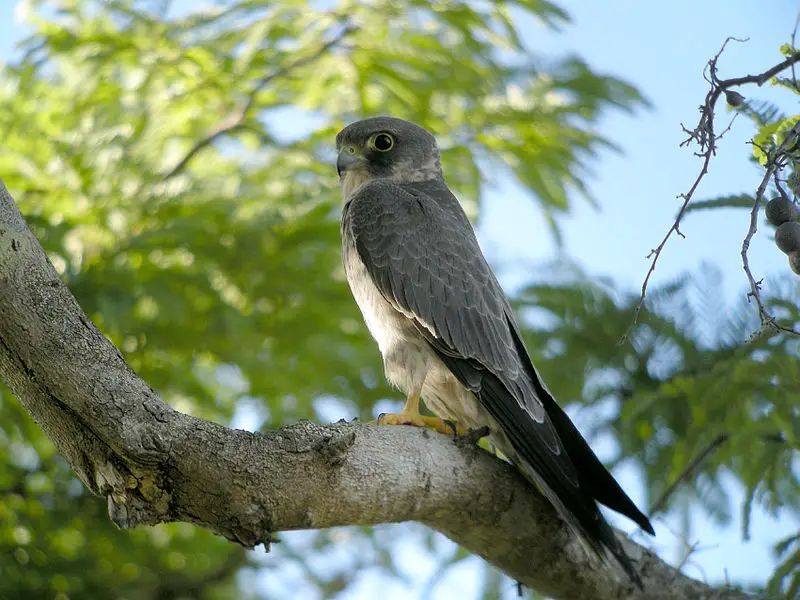
The Sooty Falcon is a medium-sized bird of prey that can be found in the arid regions of northeastern Africa and southern Persian Gulf region. The name comes from its dark soot colored plumage, which provides camouflage while hunting.
It belongs to the order Falconiformes, family Falconidae and genus Falco. This species is known for its strong flight capabilities; they often soar up high looking for their food sources such as small birds or rodents on the ground below them.
They also have sharp talons and powerful beak used to capture their prey with ease.
These raptors are an important part of local ecosystems by controlling rodent populations and providing people with opportunities for falconry sport (hunting).
In addition, due to their attractive coloring they are popular amongst birdwatchers who appreciate these majestic creatures when seen in nature.Scientific classification:
| Kingdom | Animalia |
| Phylum | Chordata |
| Class | Aves |
| Order | Falconiformes |
| Family | Falconidae |
| Genus | Falco |
| Species | F. concolor |
33. Taita Falcon
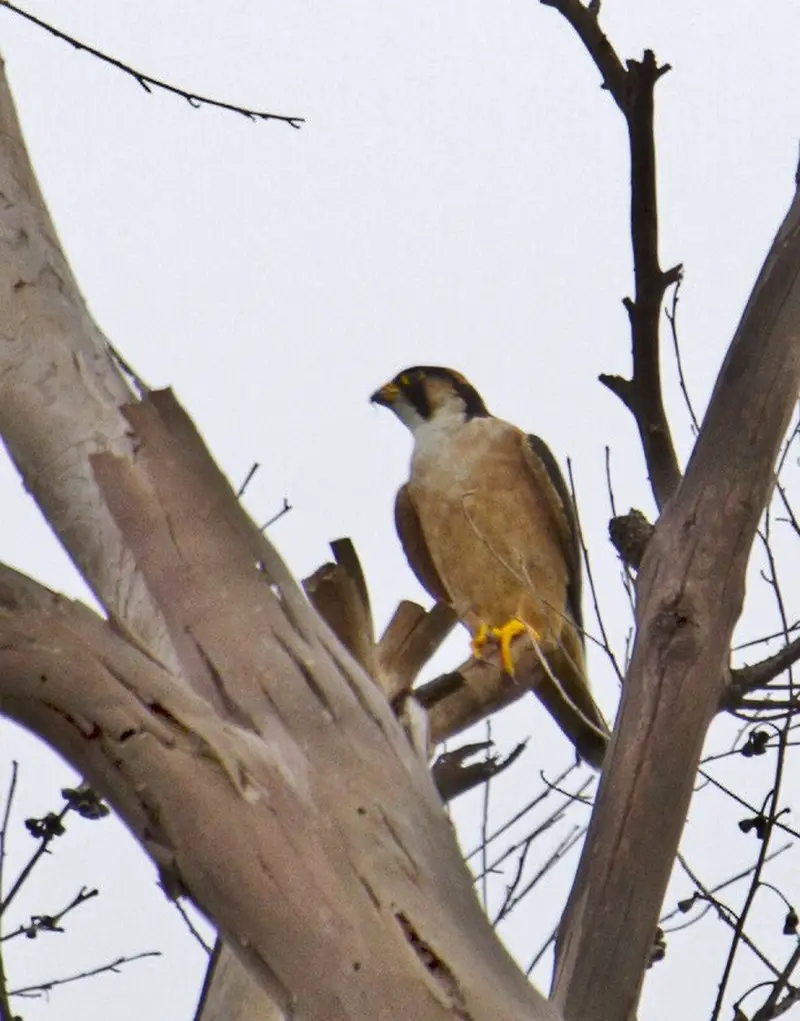
The Taita falcon is a small, rare raptor bird found in the central and eastern parts of Africa. It derives its name from the Taita Hills in Kenya where it was first discovered.
This species features long wings and a short tail that allow it to be an expert at aerial hunting.
Despite this impressive ability, not much else is known about their ecology or biology as they are quite uncommon compared to other raptors.
Although more research needs to be done on them, we can appreciate how unique and amazing these creatures are just by looking up into the sky during dusk when they come out foraging for food.Scientific classification:
| Kingdom | Animalia |
| Phylum | Chordata |
| Class | Aves |
| Order | Falconiformes |
| Family | Falconidae |
| Genus | Falco |
| Species | F. fasciinucha |
34. Eurasian Hobby
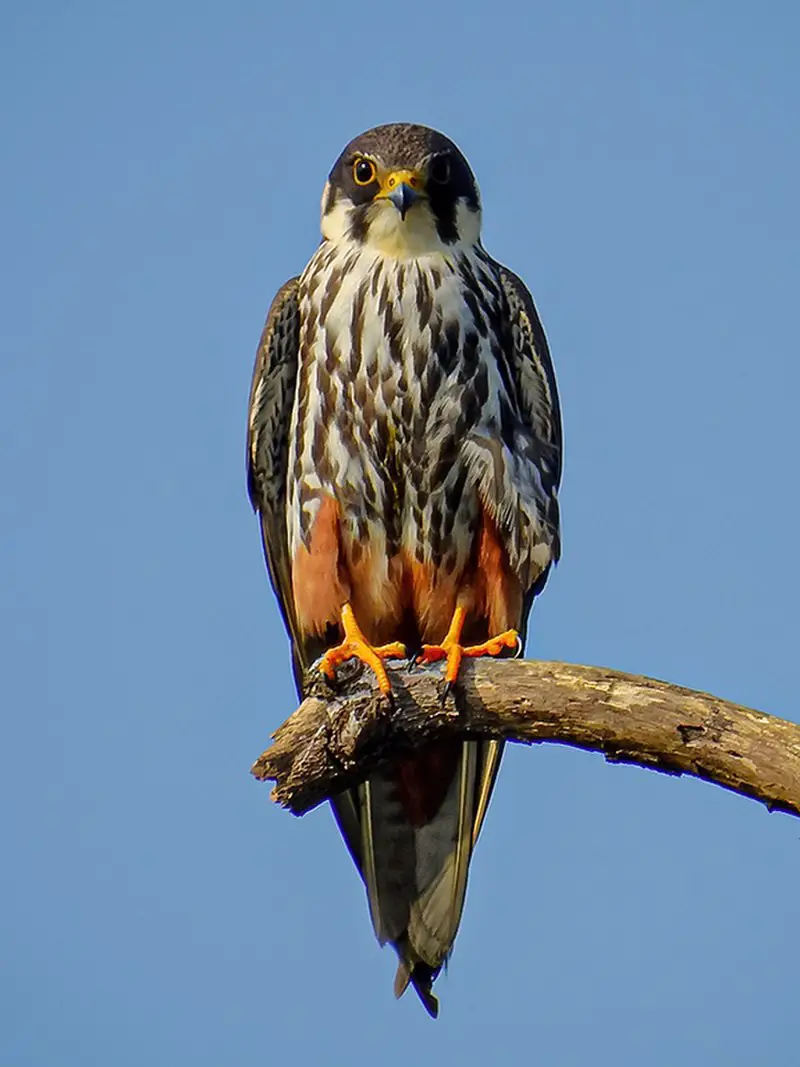
The Eurasian hobby, or simply Hobby, is a small and slim falcon belonging to the Hypotriorchis subgenus. The species was first formally described by Swedish naturalist Carl Linnaeus in 1758 as Falco subbuteo.
It has long pointed wings and tail that allow it to perform acrobatic maneuvers when hunting for prey such as dragonflies, swallows and swifts in flight.
Its habitat includes open woodland areas with tall trees suitable for nesting where it can be seen gliding gracefully on its silent wings during the summer months of northern Europe.
This shy bird of prey is an amazing sight due to its agility and speed; a true symbol of majesty in nature.Scientific classification:
| Kingdom | Animalia |
| Phylum | Chordata |
| Class | Aves |
| Order | Falconiformes |
| Family | Falconidae |
| Genus | Falco |
| Species | F. subbuteo |
35. Laggar Falcon
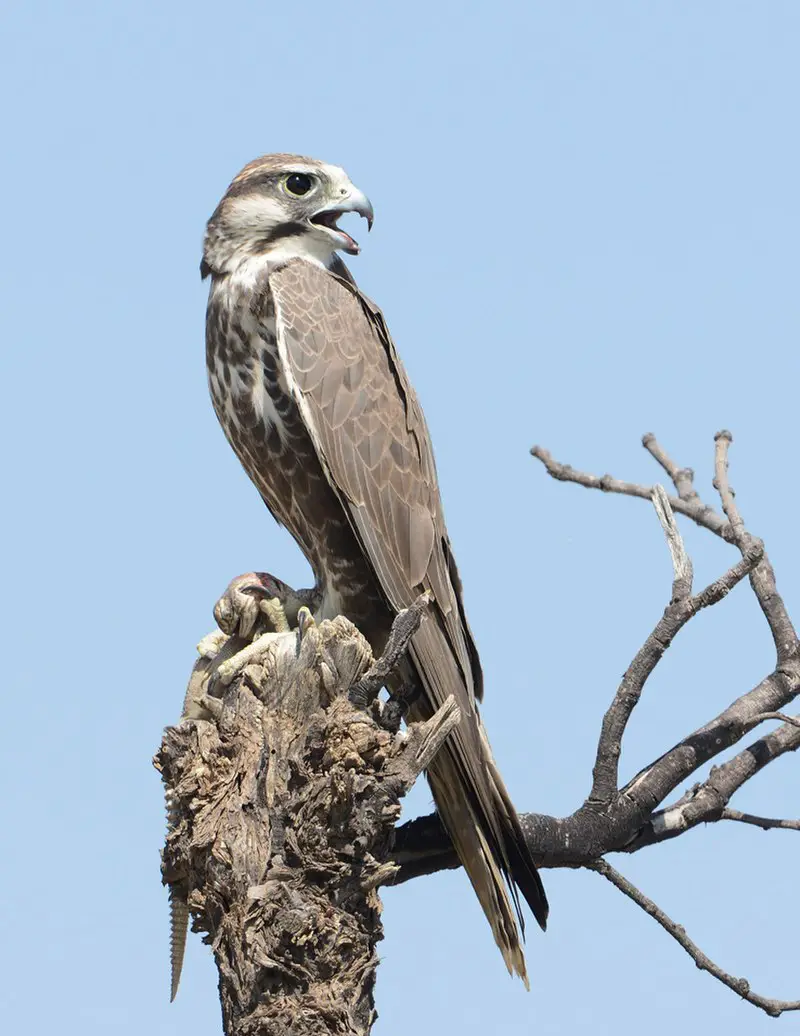
The Laggar falcon is a bird of prey found in the Indian subcontinent. It has an overall dark colouration, with blackish “trousers”, and closely resembles the Lanner Falcon.
Its range stretches from southeastern Iran to northwestern Myanmar, including Pakistan, India, Nepal, Bhutan and Bangladesh.
These birds are usually seen soaring high above their preferred habitats: open grasslands or scrubby forests that provide them access to small mammals such as hares and rodents which they hunt for food.
They mostly feed on carrion but also take birds up to the size of pigeons or doves when active hunting opportunities arise.
Their conservation status is listed by IUCN as Least Concern due to its wide distribution across multiple countries within South AsiaScientific classification:
| Kingdom | Animalia |
| Phylum | Chordata |
| Class | Aves |
| Order | Falconiformes |
| Family | Falconidae |
| Genus | Falco |
| Subgenus | Hierofalco |
| Species | F. jugger |
Also Featured In: Gujarati Birds, Birds that Live in Rajasthan
36. Crested Caracara
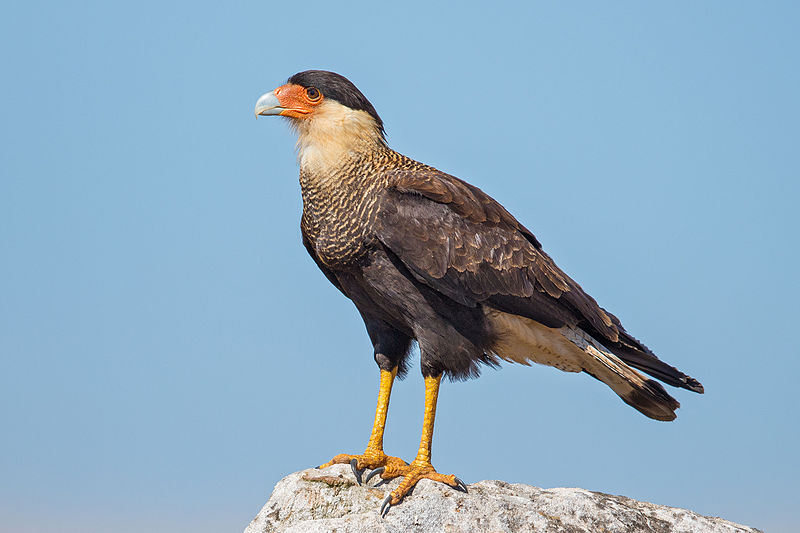
The Crested Caracara is a majestic bird of prey found from the Southern United States through Central and South America, all the way down to Tierra del Fuego.
It has an impressive wingspan ranging from 120-132 cm, with adults averaging 1,348 g in weight. This species is known for its characteristic crest on top of their head that can be raised when they are alarmed or excited.
They have pale yellow legs and feet along with dark brown feathers covering most of their body.
The Crested Caracara feeds mainly on carrion but will also take live food such as small mammals, reptiles and birds as well as garbage if it’s available near them.
These amazing raptors form strong family bonds between siblings which often last until adulthood; making them one of nature’s most remarkable creatures.Scientific classification:
| Kingdom | Animalia |
| Phylum | Chordata |
| Class | Aves |
| Order | Falconiformes |
| Family | Falconidae |
| Genus | Caracara |
| Species | C. plancus |
37. Eleonora’s Falcon
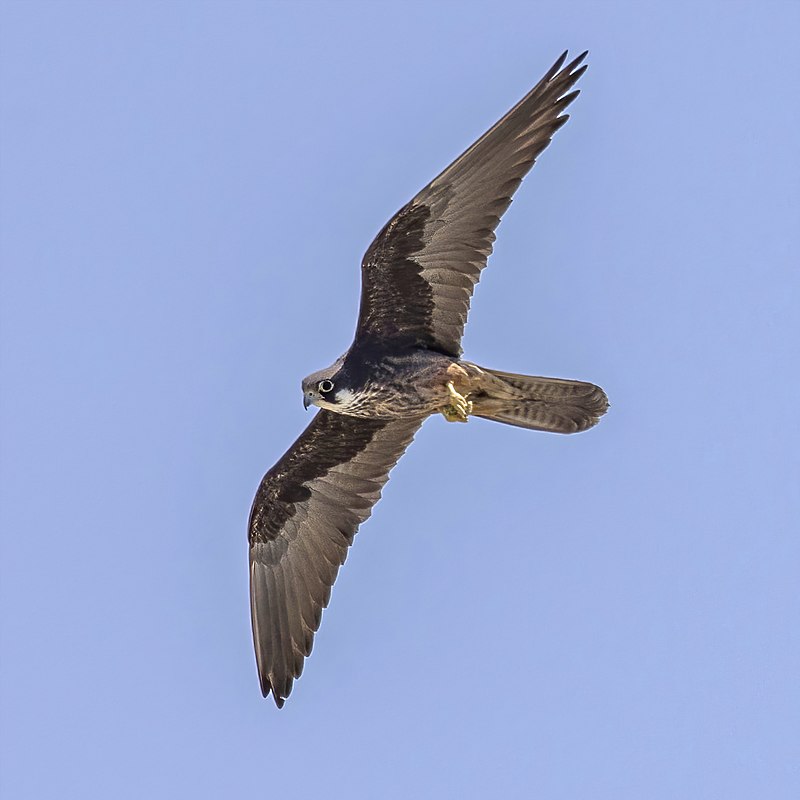
Eleonora’s falcon is a medium-sized bird of prey that belongs to the hobby group of similar species. It has distinct features such as its light brown back, white belly and dark eye stripe.
This stunning creature can be found in parts of Europe, North Africa and Asia Minor where it feeds mainly on lizards, large insects and small birds.
Its conservation status is currently stable due to successful breeding programs across many countries which have helped prevent any further declines in population size.
Eleonora’s Falcon also plays an important role in maintaining balance within ecosystems by controlling pest populations like mice or locusts.
All these attributes make this beautiful raptor a truly remarkable animal worthy of admiration.Scientific classification:
| Kingdom | Animalia |
| Phylum | Chordata |
| Class | Aves |
| Order | Falconiformes |
| Family | Falconidae |
| Genus | Falco |
| Species | F. eleonorae |
38. Fox Kestrel
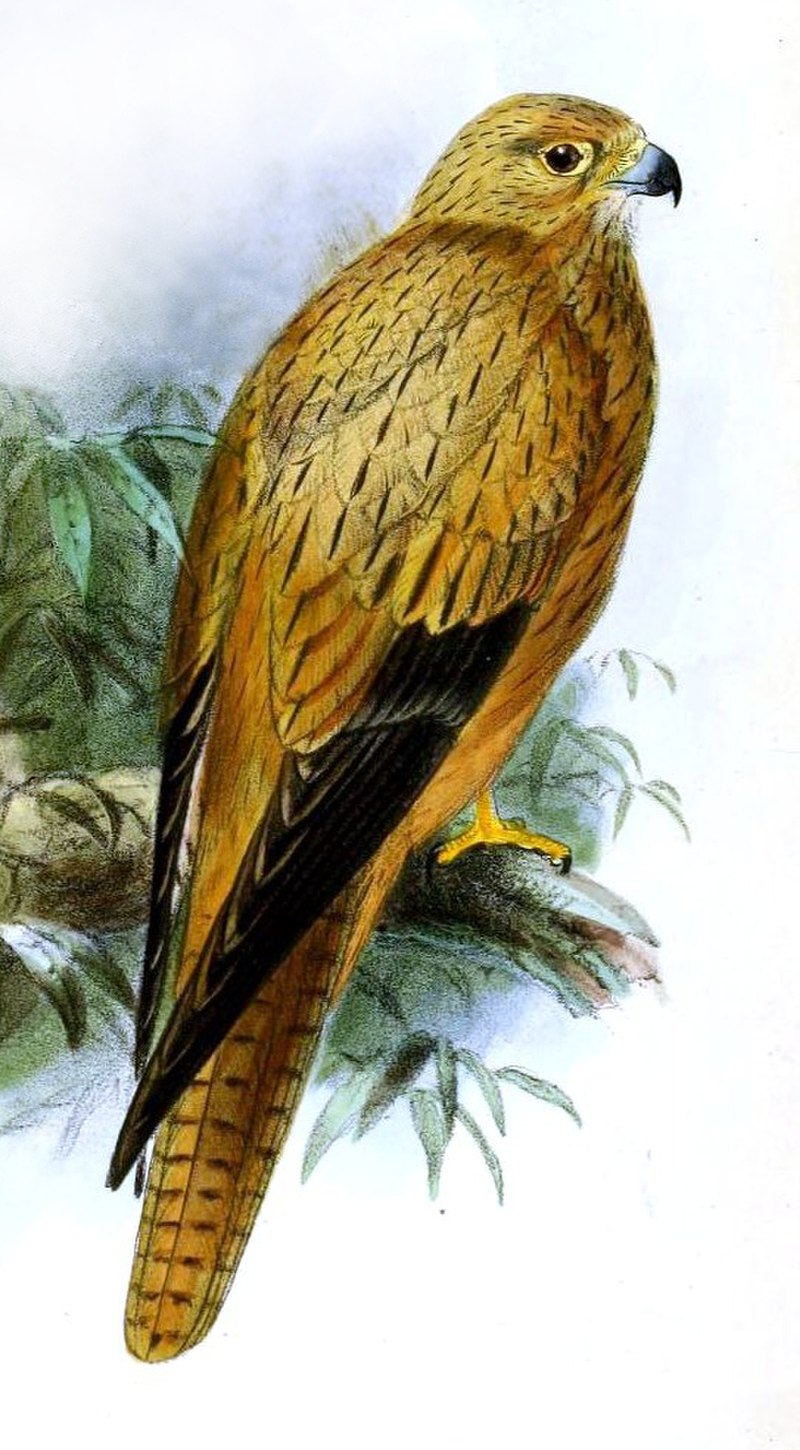
The Fox Kestrel is a bird of prey belonging to the falcon family Falconidae. It inhabits arid, open regions in northern Sub-Saharan Africa and is characterized by its long and slender wingspan as well as tail.
The average size of this species ranges from 32–38 cm (13–15 inches) with a weight ranging between 250 – 300 g (8.8 – 10.6 oz).
The female fox kestrels are on an average 3% larger than their male counterparts while they possess similar plumage color range including greyish brown above along with paler buff underneath both having dark barring patterns over them.
In addition, it has black patches around eyes accentuated by narrow white stripes running through forehead up to nape part making it unmistakable among other birds in the regionScientific classification:
| Kingdom | Animalia |
| Phylum | Chordata |
| Class | Aves |
| Order | Falconiformes |
| Family | Falconidae |
| Genus | Falco |
| Species | F. alopex |
39. Pygmy Falcon
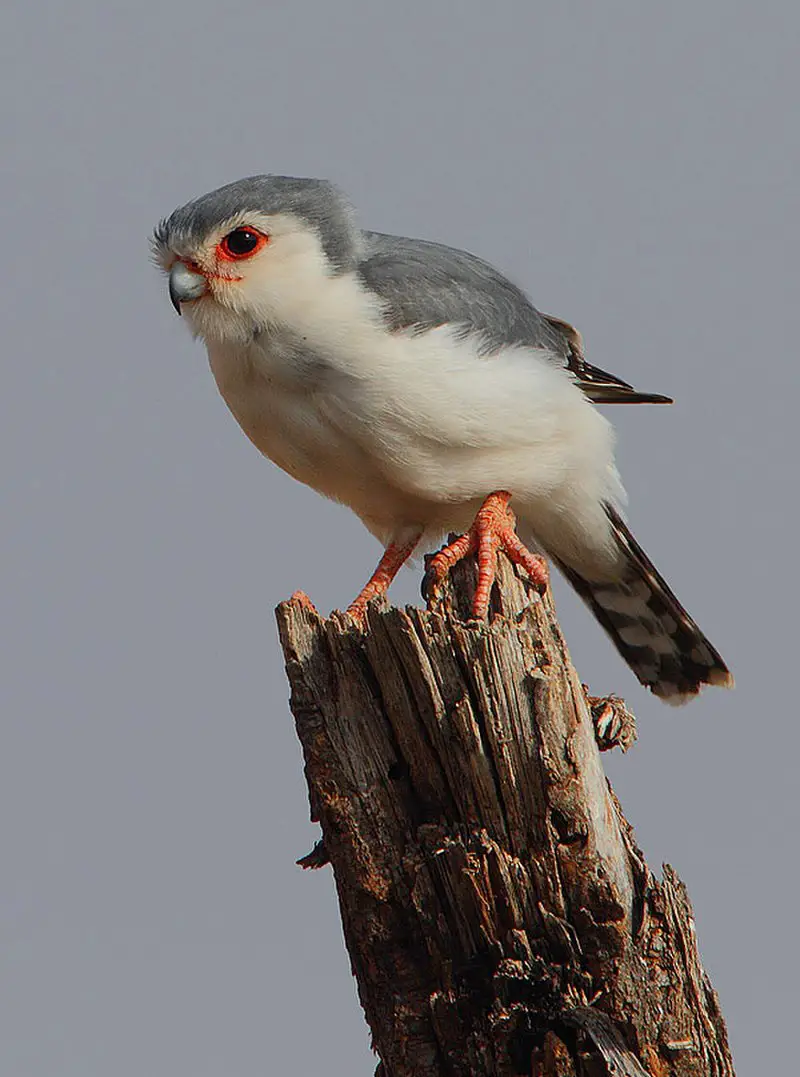
The Pygmy Falcon is a small bird of prey native to eastern and southern Africa. It stands out in its environment due to its diminutive size, being the smallest species of raptor on the continent.
Adults have white bellies, grey backs, chestnut coloured back for females and white “eye spots” at their nape. Juveniles are brown with a rufous wash on their wings and tail feathers.
These birds can be seen hunting smaller animals such as lizards or insects during daylight hours but also hunt in pairs at night when they focus mainly on rodents and bats that roost near tree branches close to ground level.
The Pygmy Falcon plays an important role in maintaining ecological balance by controlling populations of mammalian pests which helps local farmers protect their crops from destructionScientific classification:
| Kingdom | Animalia |
| Phylum | Chordata |
| Class | Aves |
| Order | Falconiformes |
| Family | Falconidae |
| Genus | Polihierax |
| Species | P. semitorquatus |
40. Collared Forest Falcon
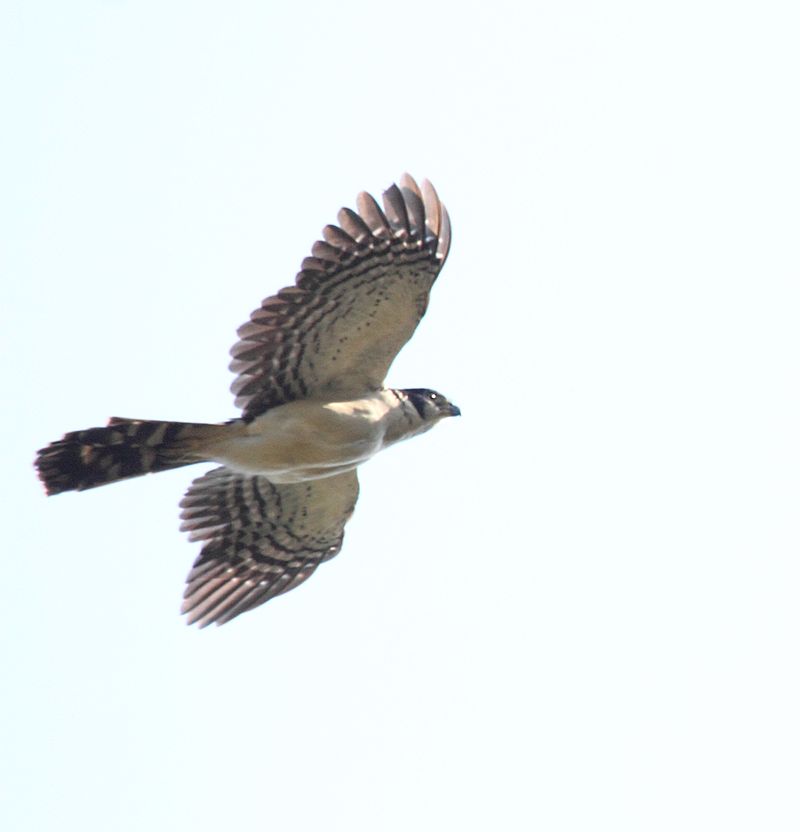
The collared forest falcon is a majestic species of bird of prey found in tropical rainforests throughout Latin America. Its size makes it the largest member of its genus, Micrastur.
It has adapted to life in dense forests by developing a morphology which allows for agility among trees and branches. Its impressive wingspan also helps it soar through the canopy with ease.
Despite their adeptness at remaining unseen, they can be heard thanks to their unmistakable call echoing from within the treetops.
Their darkly-colored feathers provide excellent camouflage within shadows and foliage making them difficult to spot without knowledge or experience of wildlife identification techniques; however when seen these birds are truly spectacular creatures that bring us closer to nature’s wonders.Scientific classification:
| Kingdom | Animalia |
| Phylum | Chordata |
| Class | Aves |
| Order | Falconiformes |
| Family | Falconidae |
| Genus | Micrastur |
| Species | M. semitorquatus |
41. Yellow-Headed Caracara
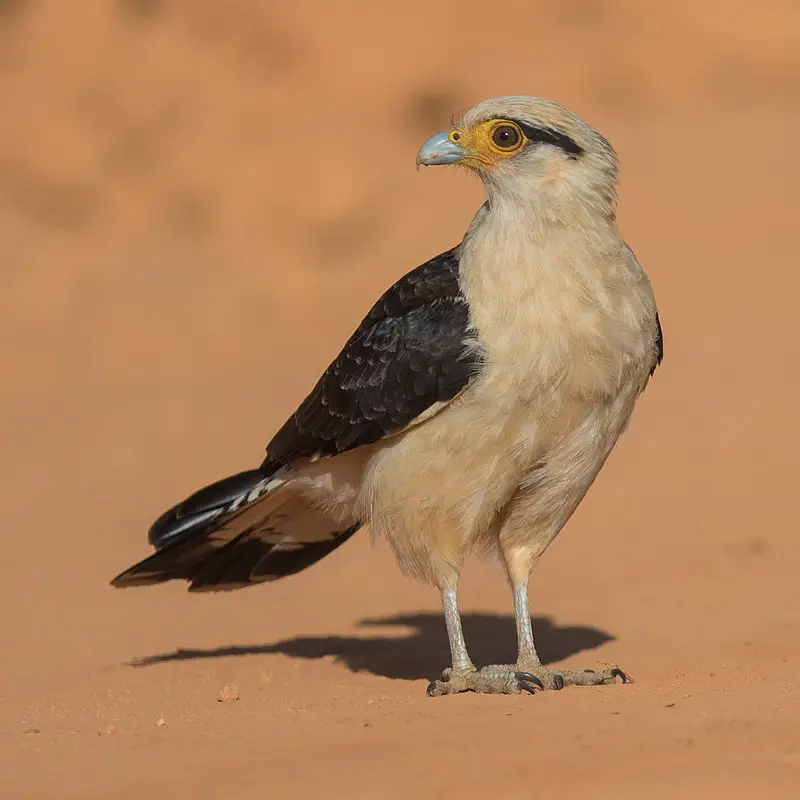
The Yellow-headed Caracara is a majestic bird of prey belonging to the Falconidae family, found in tropical and subtropical South America and southern parts of Central America.
It has an unmistakable bright yellow head that sets it apart from other birds. Unlike its cousins who specialize in fast aerial hunting, the caracara feeds on scavenged food such as dead animals or eggs instead.
Louis Jean Pierre Vieillot first described this species when he discovered them back in 1817. The size varies between 33 cm – 45 cm with wingspan ranging up to 90 cm long.
These stunning birds have a unique red face mask along with black & white plumage across their body which makes them very distinctive looking creatures indeed.Scientific classification:
| Kingdom | Animalia |
| Phylum | Chordata |
| Class | Aves |
| Order | Falconiformes |
| Family | Falconidae |
| Genus | Milvago |
| Species | M. chimachima |
42. Cryptic Forest Falcon
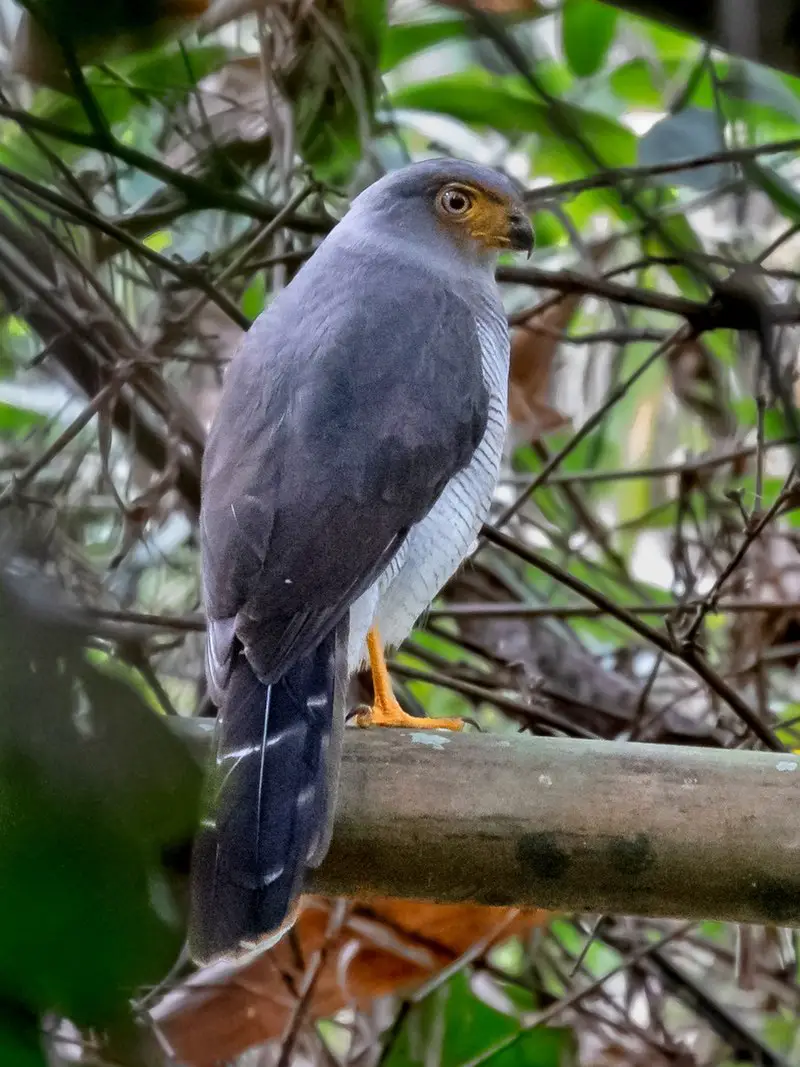
The Cryptic Forest Falcon is a beautiful bird of prey that lives in the southeastern Amazon rainforest. It has long been mistaken for its more common cousin, the Lined Forest Falcon, due to their similar appearance.
Despite being uncommon in this region, it remains widespread and therefore rated as least concern by BirdLife International and IUCN.
The falcon is predominantly gray-brown with white barring on its underparts, while juveniles have streaking on their heads instead of barring.
They are also known to make an unusual “screaming” call which they use when hunting or defending territory from other birds of prey.
With some conservation efforts put into place to protect these magnificent creatures, hopefully they will remain a part of our planet’s ecosystem for many years to come.Scientific classification:
| Kingdom | Animalia |
| Phylum | Chordata |
| Class | Aves |
| Order | Falconiformes |
| Family | Falconidae |
| Genus | Micrastur |
| Species | M. mintoni |
43. Buckley’s Forest Falcon
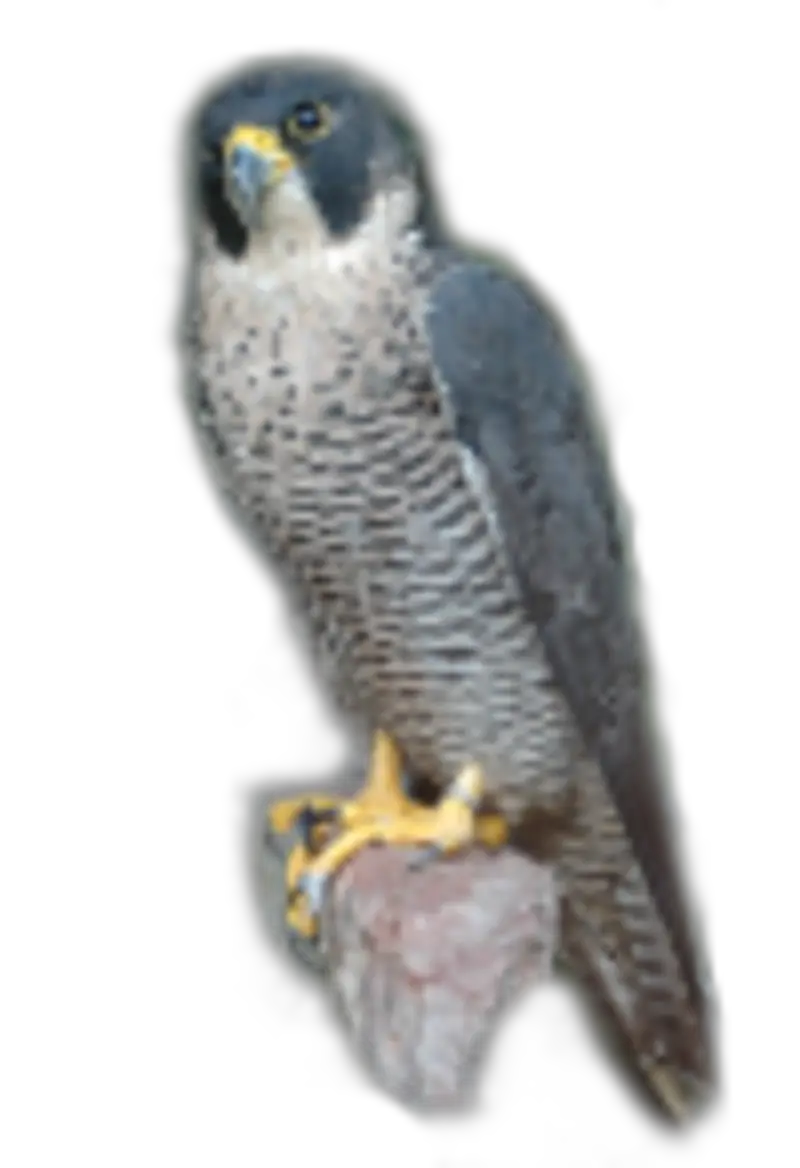
Buckley’s forest falcon is a species of bird of prey found in the Amazon basin. It has an unmistakable look with its orange head and chest, dark back, white underparts and black-tipped wings.
This medium-sized raptor typically inhabits subtropical or tropical moist lowland forests but can sometimes be spotted soaring over open areas looking for food.
Despite having some conservation measures put in place to protect it from human activities such as deforestation, this species is still at risk due to habitat loss caused by unsustainable logging practices.
To ensure their survival, more efforts need to be made to preserve their natural habitats so that future generations may continue enjoying them in all their glory.Scientific classification:
| Kingdom | Animalia |
| Phylum | Chordata |
| Class | Aves |
| Order | Falconiformes |
| Family | Falconidae |
| Genus | Micrastur |
| Species | M. buckleyi |
44. Lined Forest Falcon
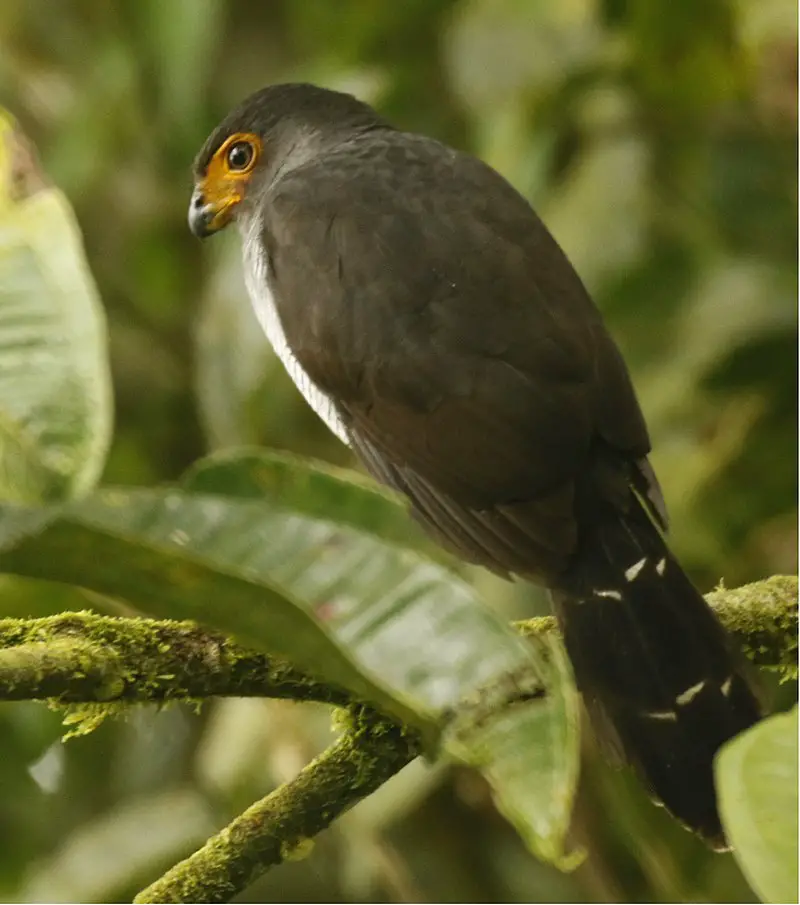
The Lined forest falcon is a bird of prey found in the western and northern Amazon Basin. It is mostly endemic to humid forests, making it an important part of its ecosystem.
The cryptic forest falcon was formerly included in this species, but due to differences between populations south-east of the Amazon River and Madeira Rivers they were later on described as new species.
This medium sized raptor has dark brown upperparts with white barring below which makes it quite distinctive amongst other birds present there.
They feed mainly on small mammals such as bats, lizards and snakes while also eating large insects like grasshoppers or beetles making them highly effective predators within their environment.Scientific classification:
| Kingdom | Animalia |
| Phylum | Chordata |
| Class | Aves |
| Order | Falconiformes |
| Family | Falconidae |
| Genus | Micrastur |
| Species | M. gilvicollis |
45. Plumbeous Forest Falcon
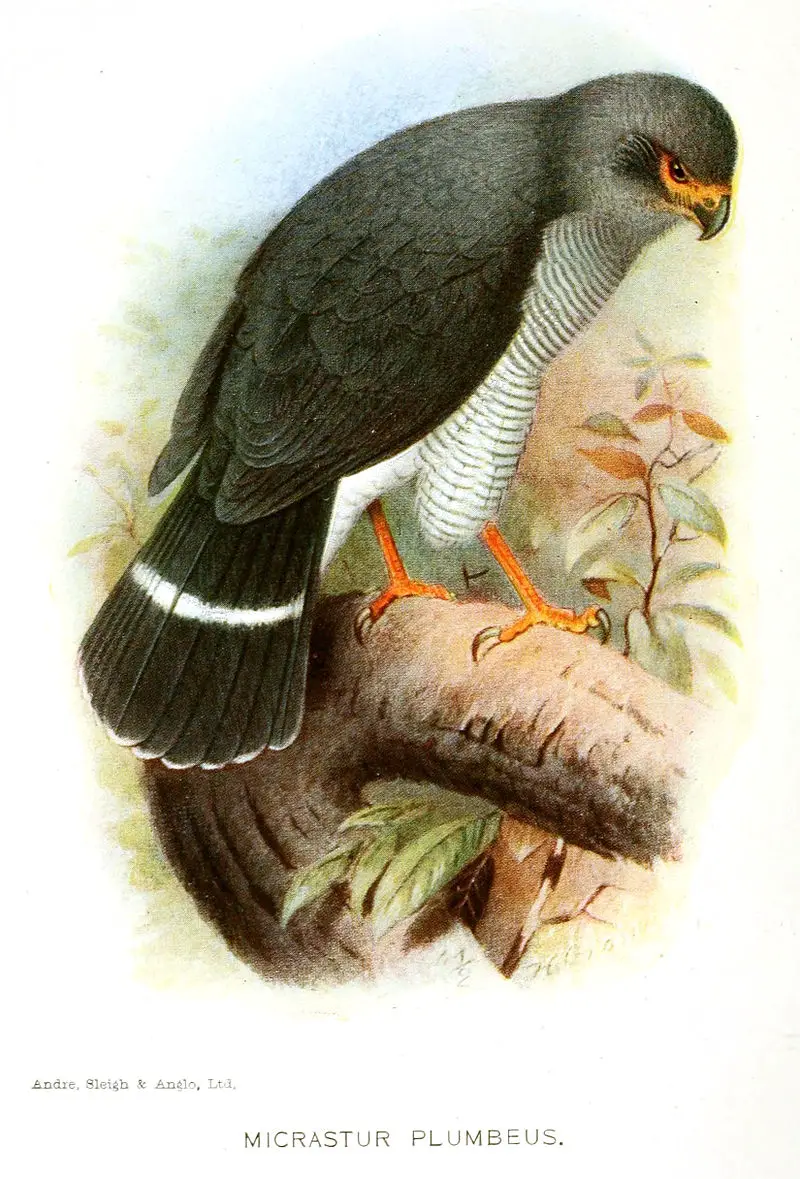
The Plumbeous Forest-Falcon is a rare bird of prey found only in the Chocó region, which spans Colombia and Ecuador.
It was once believed to be part of the Lined Forest-Falcons but has since been classified as its own species.
Due to its rarity, it is considered vulnerable and conservation efforts have been taken to ensure its survival.
The plumage of this falcon is usually grey with a brownish tinge on top while white underneath; they also have yellow legs and feet.
Its diet mainly consists of small birds such as hummingbirds or doves although they may occasionally consume other mammals like bats or rodents too.
They are most active during dawn and dusk when searching for food or roosting sites so these times make them easier to observe if you’re lucky enough.Scientific classification:
| Kingdom | Animalia |
| Phylum | Chordata |
| Class | Aves |
| Order | Falconiformes |
| Family | Falconidae |
| Genus | Micrastur |
| Species | M. plumbeus |
46. Black-Thighed Falconet
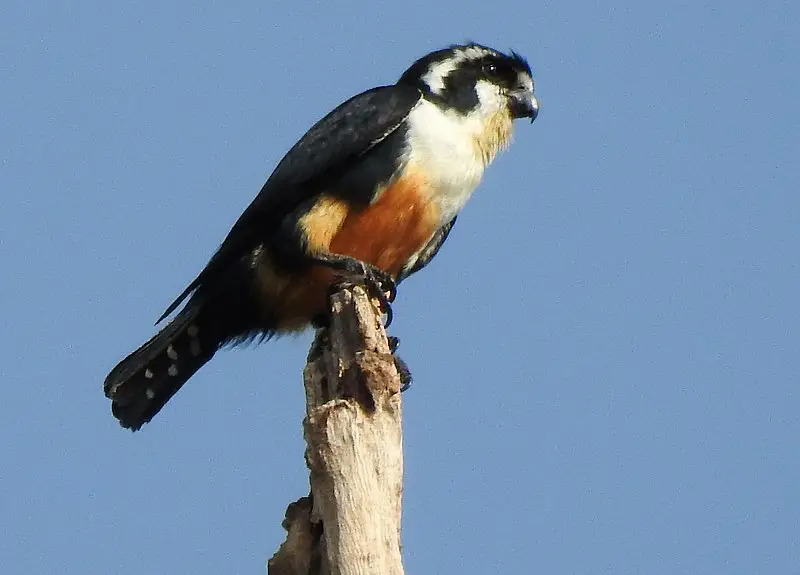
The Black-thighed Falconet is one of the smallest birds of prey in existence. It typically measures between 14–16 centimetres long, with a wingspan of 27–32 cm – about the size of a sparrow.
This species can be found in Brunei Darussalam, Myanmar, Thailand, Malaysia, Singapore and Indonesia.
Thomas Horsfield described it as having striking black legs which contrast against its brown upperparts and white underbelly.
Its tail has alternating bands which helps to distinguish it from other similar looking bird species.
The diet for this raptor consists mostly on flying insects such as dragonflies or grasshoppers but they have also been known to eat small reptiles or amphibians when available.Scientific classification:
| Kingdom | Animalia |
| Phylum | Chordata |
| Class | Aves |
| Order | Falconiformes |
| Family | Falconidae |
| Genus | Microhierax |
| Species | M. fringillarius |
47. Collared Falconet
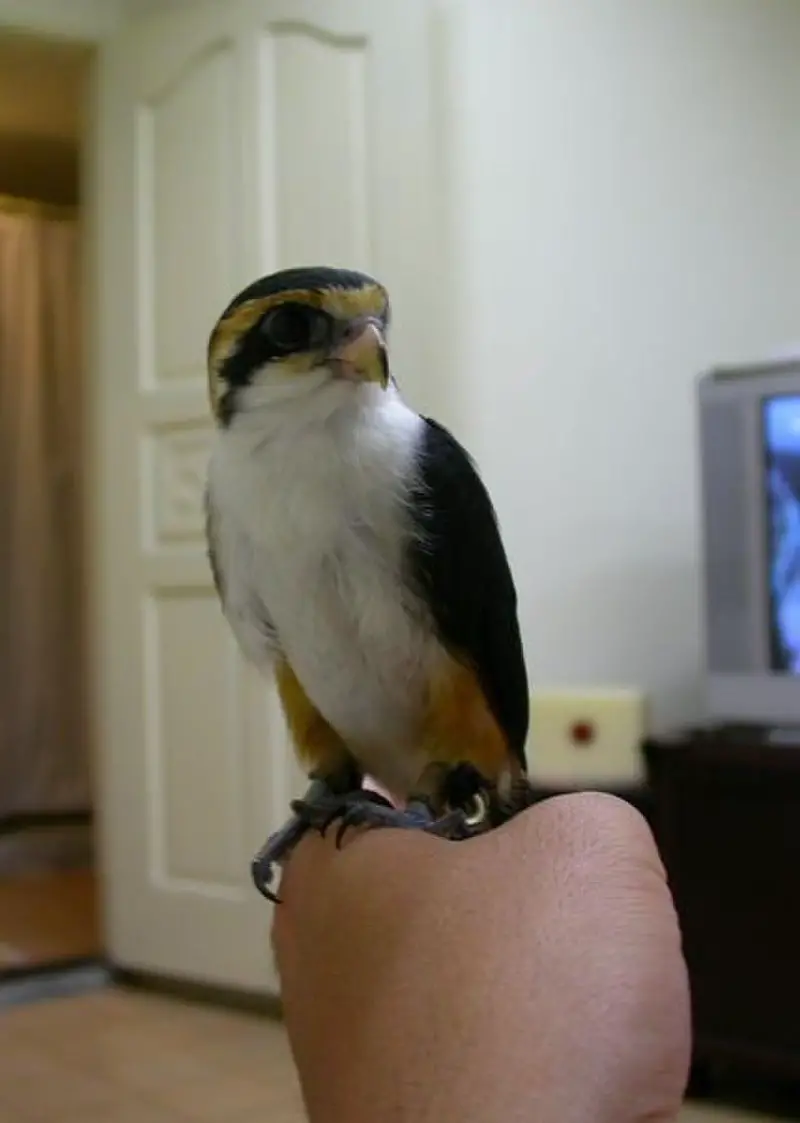
The Collared Falconet is a species of bird of prey belonging to the family Falconidae.
It is found mainly in parts of Southeast Asia and India, including Bangladesh, Bhutan, Cambodia, India, Laos Myanmar Nepal Thailand Malaysia and Vietnam.
It has an average length of 18 cm (7.1 inches). Its natural habitat consists mostly of temperate forest edges with broadleaf forests.
This small falcon usually hunts by rapidly beating its wings as it moves around in search for food like insects or lizards on branches or trees nearby.
The Collared Falconet’s diet also includes small birds such as doves and finches which it catches mid-air after diving from great heights at high speeds if need be.Scientific classification:
| Kingdom | Animalia |
| Phylum | Chordata |
| Class | Aves |
| Order | Falconiformes |
| Family | Falconidae |
| Genus | Microhierax |
| Species | M. caerulescens |
48. Philippine Falconet
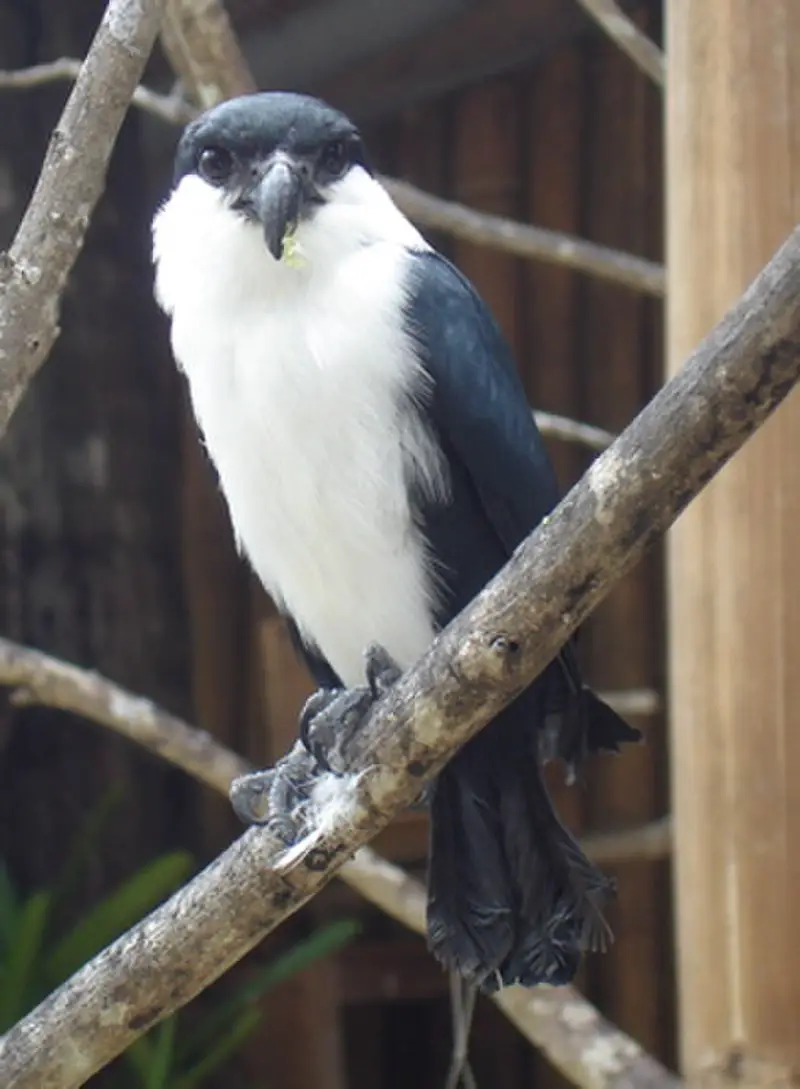
The Philippine falconet is a species of bird of prey that is endemic to the lowland forests in Philippines.
They can be seen near open forest edges hunting flying insects and nesting in woodpecker holes of dead trees.
It’s fairly common within their suitable habitats, though it has become threatened due to deforestation and illegal trapping for pet trade.
Its diet consists mainly of insects such as beetles, moths and grasshoppers which they catch mid-flight with its powerful talons while soaring up high.
Conservation efforts have been put into place to preserve this beautiful creature from extinction by protecting its habitat and monitoring the illegal trading activities so that future generations can witness them in their natural environment.Scientific classification:
| Kingdom | Animalia |
| Phylum | Chordata |
| Class | Aves |
| Order | Falconiformes |
| Family | Falconidae |
| Genus | Microhierax |
| Species | M. erythrogenys |
49. White-Fronted Falconet
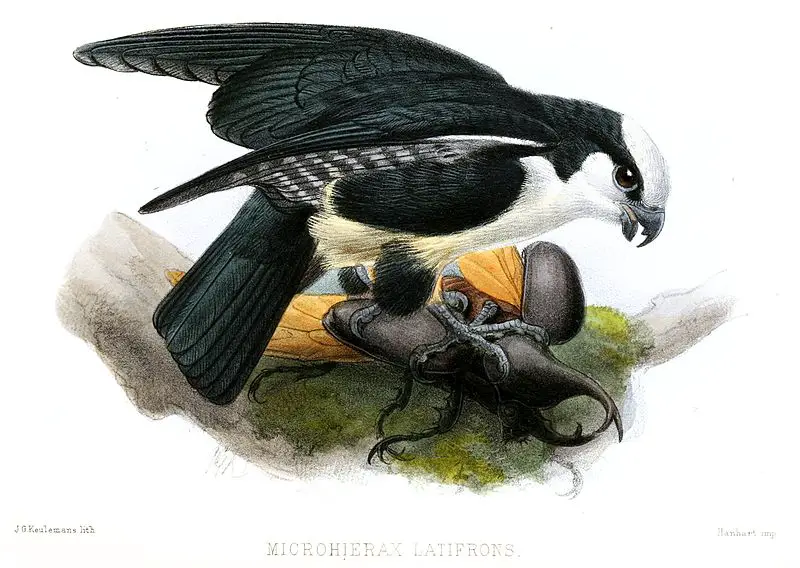
The White-fronted Falconet is a small bird of prey found only in Borneo. It measures between 14 and 17 cm long, with an average weight of 35 to 65 grams.
This species was first described by Richard Bowdler Sharpe in 1879 and it inhabits areas like Sarawak, Sabah and northeastern Kalimantan.
The falconet has white forehead that gradually fades into black wings which have distinct red patches on them.
Its tail is also black but the lower half has narrow white bars along its length giving it a unique appearance from other birds of similar size.
The diet mainly consists of insects such as beetles, grasshoppers or dragonflies; however sometimes they can feed on larger animals like lizards or even mice.
They are very agile hunters often seen flying low over fields searching for their next meal.Scientific classification:
| Kingdom | Animalia |
| Phylum | Chordata |
| Class | Aves |
| Order | Falconiformes |
| Family | Falconidae |
| Genus | Microhierax |
| Species | M. latifrons |
Also Featured In: Birds that Live in Borneo Island,
50. Pied Falconet
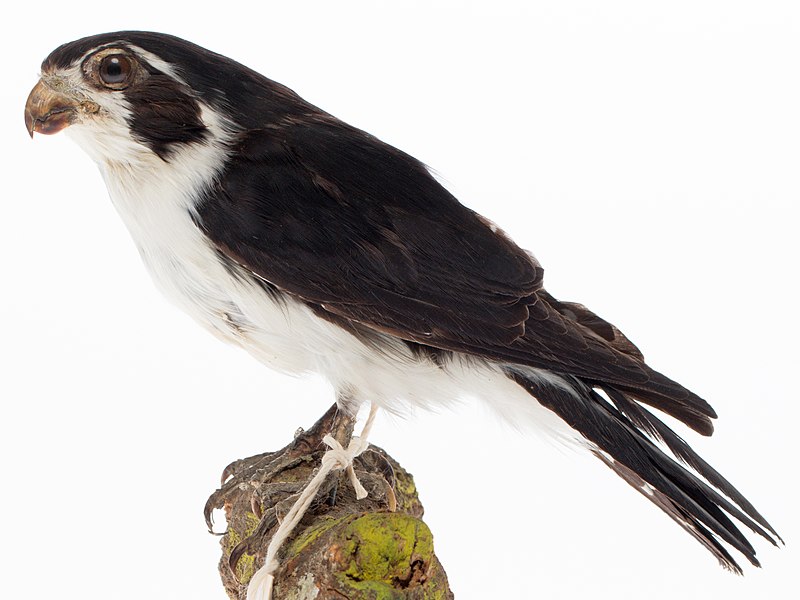
The Pied Falconet is a species of bird of prey belonging to the family Falconidae. It resides in countries such as Bangladesh, Bhutan, China, Hong Kong India and Vietnam amongst others.
The raptor prefers temperate forest areas for its habitat. This particular species belongs to the Microhierax genus which includes some of the smallest birds of prey on Earth and are also known as white-legged falconets due to their distinct colouring.
They build nests usually high up in trees or cliffs so they can protect themselves from predators while still being able to spot preys easily with their sharp eyesight.
These small but mighty creatures are an important part of our ecosystem – it’s vital that we continue protecting them.Scientific classification:
| Kingdom | Animalia |
| Phylum | Chordata |
| Class | Aves |
| Order | Falconiformes |
| Family | Falconidae |
| Genus | Microhierax |
| Species | M. melanoleucos |